could
↑ objectName, objectTitle:
objectTitle :
collectionName : collectionNameinventoryNb : inventoryNb
objectName : objectName
objectTitle : objectTitle
objectCulture : objectCulture
geography : geography
dating : dating
material : material
technique : technique
dimensions : dimensions
legalRightOwner : legalRightOwner
objectDescription : objectDescription

↑ , Quinton d'amour:
Quinton d'amour :
collectionName : String instrumentsinventoryNb : 1358
objectName :
objectTitle : Quinton d'amour
objectCulture :
geography :
dating : AD 1730 - AD 1772
material :
technique :
dimensions : Height: 64,6 cm, Width: 20,3 cm
legalRightOwner : Musées royaux d'art et d'histoire/Koninklijke Musea voor Kunst en Geschiedenis
objectDescription : Quinton d'Amour with 5 stopped strings and 6 sympathetic strings, covered with a red-brown varnish. The strings are attached to a white plate with pins, at the bottom of the ribs, as was the case with the other quinton d’amour and the viola d’amore by Salomon (inv. No. 0481 and 1389). The sympathetic strings run over the top of this plate, which serves as a kind of high bottom nut, in which holes for the melodic strings were provided. A tailpiece was not necessary with this construction. The two parts back with three-part purfling is arched. Ribs and back are made of flamed maple. The sound box has a normal violin shape, with corner blocks and glue strips on the inside and with f-holes in the two-part spruce top, also with three-part purfling. The top has repaired fractures. In the upper block one can see three holes where there used to be nails for the attachment of the neck. A classic violin curl closes the pegbox. The latter is decorated with floral patterns at the back and on the sides. Furthermore, it is fully open at the front and closed at the back for four of the five melody strings. The fingerboard, open at the back for the resonance strings, has a layer of veneered ebony at the front and bears traces of bound frets. This instrument (inv. No. 1358) is similar to Salomon's other quinton d'amour (inv. No. 0481), but the edges and corners of top and back seem heavier, while the varnish also differs in color and texture from those of both other Salomon instruments from the collection (inv. no. 0481 and 1389). Moreover the neck is more rounded, which does not facilitate playing in the "da gamba" position. The instrument may have been assembled, rebuilt or completely constructed by a certain Jean Leclerc, who then signed the instrument inside with a pencil. Maybe this could be Joseph-Nicolas Leclerc from Mirecourt, working in Paris since 1760. This quinton d 'amour (inv. No. 1358) was part of the Auguste Tolbecque collection. In 1879 his collection of musical instruments was purchased by the Instrument Museum. In 1885 a viola d’amore by Salomon from the Museum in London was exhibited. Perhaps this instrument was meant, or else the quinton d’amour (inv. No. 0481) or the viola d’amore (inv. No. 1389), both also by his hand. Labels: 1) "SALOMON / A PARIS" (brand) 2) "Jean nicolas / leclerc" (handwriting on the back) L. approximately 65.2 cm L. approx. 25 cm H. sides approx. 31 cm String length approx. 32.8 cm. Bibliography Victor-Charles Mahillon, Catalogue descriptif et analytique du Musée Instrumental du Conservatoire Royal de Musique de Bruxelles, pt. 3, Ghent, 1900, p. 26.

↑ , :
:
collectionName : Percussion instrumentsinventoryNb : 1975.027
objectName :
objectTitle :
objectCulture :
geography :
dating : AD 1664
material :
technique :
dimensions :
legalRightOwner : Musées royaux d'art et d'histoire/Koninklijke Musea voor Kunst en Geschiedenis
objectDescription : For more than three centuries, this bell was the soul of Avignon-lès-Saint-Claude, a small village in the Jura Mountains (eastern France). With its ringing it watched over the surrounding woods and fields. It was cast in 1664, and it hung in the tower of a chapel that had been erected some years before, in 1649, in gratitude after the village had escaped the plague epidemic that had hit the area in 1629 and 1636. The chapel was devoted to Saint Roch, the patron saint against the plague. The inscription ‘STE ROCHAE ORA PRO NOBIS’ on the bell bears testimony to this. The body bears different images: a big crucifix adorned with vegetal garlands, a baroque calvary crowned with the sun and the moon, effigies of the Virgin Mary, of Saint Roch himself with his dog, and of a blessing bishop with a child at his feet. This is Saint Claudius, who was reputed to revive stillborn babies for the time of their baptism. In 1975, as the bell was cracked, it was replaced by a new one, after which it was donated to the Musical Instruments Museum. This bell was made by Michel Jolly, a bell-founder from the village of Breuvannes-en-Bassigny, who would be succeeded by his four sons. The Bassigny is an area in the neighbourhood of Langres. In those times it was a hotbed of highly reputed wandering bell-founders. From the sixteenth century onwards they travelled all over eastern France and the neighbouring Swiss cantons from spring to autumn. They set up their workshops wherever their services were required. The first permanent workshops only arose late in the nineteenth century. Until then, bells were cast on the spot, in front of, and sometimes even inside the church. Two casting moulds are still to be seen in the basement of the nearby church of Saint Lupicin. The casting of a bell was an important occasion in the life of a village community. The extant contracts of parishes with bell-founders often show the enthusiasm the event sparked off, and they also provide surprising details about the bulk of the materials the client had to provide: up to thirty cartloads of stone and clay to make the mould and the oven, and up to thirty cartloads of coal and firewood. Workers had to be hired to mould the clay and cleave the wood, and to hang the finished bell in the tower. The bell-founder could count on the passionate help of the local community around him. When the mould was ready, it was buried in a hole and carefully covered with earth. Then the bell-metal – an alloy containing around 80% copper and 20% tin – was heated to 1200° C. Every maker had his own ‘secret’ recipe, which added to the mystery around bell founding. When the metal was liquid, the trapdoor of the oven was opened. Through a channel the metal slid into the mould like a fire snake, and disappeared into the earth. The whole process only took a few moments. In the old times the bell makers liked to wait until night had fallen. Then the scene looked even more magical and spectacular in the eyes of the excited villagers who had gathered to experience the ‘miracle’. Once the cast was taken from the mould, it was washed and consecrated, or ‘baptized’ in popular speech, as it was given godparents and a Christian name. This bell was baptized Marie-Joseph, and ‘F. IAILLO’ and ‘DENISE COLIN’ were named as godparents. We don’t know exactly who they were. However, both surnames were well attested in the village at the time. ‘F. Iaillo’ undoubtedly points at a member of the Jaillot family, which produced two brothers who made a career at the court of Louis XIV: Hubert (1640-1712), a prominent geographer, and Pierre Simon (1631-1681), a famous ivory sculptor. Some other Jaillots from Avignon-lès-Saint-Claude were also successful in Paris. In a village of barely 120 souls at the time, all these Jaillots must have been relatives of the godfather of our bell. Further investigation could clarify this. Stéphane Colin Inscription : + IHS MAR JOSEPH ◊ STE ROCHAE ORA PRO NOBIS ◊1664 ◊ + HON ◊F◊ IAILLO FILӠ DE FEUT ◊P◊ IAILLO DAVIGNON BOURGOIS DE ST CLAUDE PARAIN + ◊ ET DENISE COLIN FEMME DHON IACQUE WILLERME DUDICT AVIGNON BOURGOIS DE ST CLAUDE MARAINE ◊

↑ , Rectangular muselar virginal:
Rectangular muselar virginal :
collectionName : Keyboard instrumentsinventoryNb : 2930
objectName :
objectTitle : Rectangular muselar virginal
objectCulture :
geography :
dating : AD 1614 (uncertain)
material :
technique :
dimensions : Length: 1667 mm, Width: 490 mm, Height: 240 mm
legalRightOwner : Musées royaux d'art et d'histoire/Koninklijke Musea voor Kunst en Geschiedenis
objectDescription : Muselar virginal on 6 legs, bearing the serial number 6/20, probably built in 1614. Restyled several times according to current tastes. In the first half of the 18th century, the original porphyry decoration was covered with a brownish colour. During the 19th century, that brown was then hidden under faux-wood and the instrument was given a new lid. Also during the 19th century, the instrument was redecorated with geometrical motifs. A new fallboard and jackrail were added. A flap was cut out of the lid above the keys while the soundboard and bridges were painted in a milky brown. The soundboard was enhanced with decorative motifs. Some of these alterations could have been the work of a certain I.B.P., who left his signature on the nameboard liner. Restored in the 1960s.
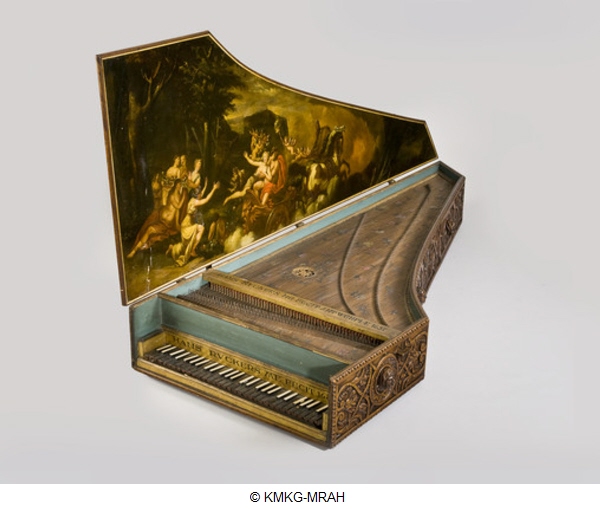
↑ , Harpsichord:
Harpsichord :
collectionName : Keyboard instrumentsinventoryNb : 4276
objectName :
objectTitle : Harpsichord
objectCulture :
geography :
dating : AD 1738
material :
technique :
dimensions : Length: 226,2 cm, Width: 90,8 cm, Height: 27,1 cm
legalRightOwner : Musées royaux d'art et d'histoire/Koninklijke Musea voor Kunst en Geschiedenis
objectDescription : Though this harpsichord was formerly considered a seventeenth-century instrument built by Hans Ruckers, analyses show that it is actually a Flemish eighteenth-century instrument. Its keyboard bears the initials c.p. and the date 1738, consistent with that of the soundboard’s wood (1730). Several authors, considering it a seventeenth-century instrument, suggested it had been considerably altered. On the contrary, as an eighteenth-century instrument, it appears to have undergone practically no modifications. The oak cladding on the case could date from the nineteenth or even twentieth century, at which time the soundboard was also decorated. The painted canvas backed onto the lid seems to date from the eighteenth century.

↑ , :
:
collectionName : Middle Ages and Modern TimesinventoryNb : B004917-002
objectName :
objectTitle :
objectCulture :
geography :
dating :
material :
technique :
dimensions : Width: 23,3 cm
legalRightOwner : Musées royaux d'art et d'histoire/Koninklijke Musea voor Kunst en Geschiedenis
objectDescription : The motte-and-bailey castle ‘Senecaberg’ (Grimbergen, Borgt) was first excavated by A. de Loë en A. Rutot (Société Royale d’Archéologie de Bruxelles) in 1890-1891. The first large-scale excavation campaign took place between 1966-1968 and was conducted by René Borremans (assistant of ME. Mariën, curator of the National Archaeology Department from 1957 to 1983). The site was founded in the last quarter of the 11th century by the Lords of Grimbergen and was taken in 1159 by Godfrey III, count of Leuven. In that same year the site was abandoned. In addition to a large amount of artefacts and bone-material, the excavators could document the foundations of different successive wooden structures on top of the mound.

↑ , :
:
collectionName : Middle Ages and Modern TimesinventoryNb : B004917-003
objectName :
objectTitle :
objectCulture :
geography :
dating :
material :
technique :
dimensions : Width: 24,9 cm
legalRightOwner : Musées royaux d'art et d'histoire/Koninklijke Musea voor Kunst en Geschiedenis
objectDescription : The motte-and-bailey castle ‘Senecaberg’ (Grimbergen, Borgt) was first excavated by A. de Loë en A. Rutot (Société Royale d’Archéologie de Bruxelles) in 1890-1891. The first large-scale excavation campaign took place between 1966-1968 and was conducted by René Borremans (assistant of ME. Mariën, curator of the National Archaeology Department from 1957 to 1983). The site was founded in the last quarter of the 11th century by the Lords of Grimbergen and was taken in 1159 by Godfrey III, count of Leuven. In that same year the site was abandoned. In addition to a large amount of artefacts and bone-material, the excavators could document the foundations of different successive wooden structures on top of the mound.
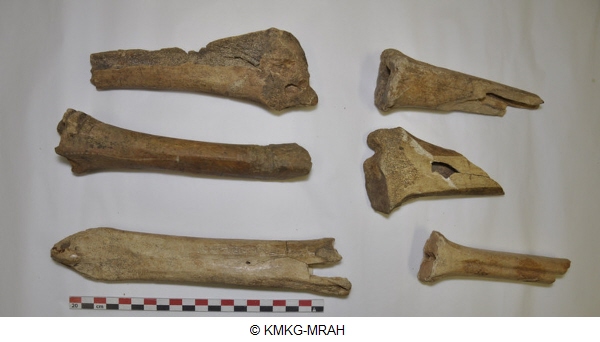
↑ , :
:
collectionName : Middle Ages and Modern TimesinventoryNb : B004917-004
objectName :
objectTitle :
objectCulture :
geography :
dating :
material :
technique :
dimensions :
legalRightOwner : Musées royaux d'art et d'histoire/Koninklijke Musea voor Kunst en Geschiedenis
objectDescription : The motte-and-bailey castle ‘Senecaberg’ (Grimbergen, Borgt) was first excavated by A. de Loë en A. Rutot (Société Royale d’Archéologie de Bruxelles) in 1890-1891. The first large-scale excavation campaign took place between 1966-1968 and was conducted by René Borremans (assistant of ME. Mariën, curator of the National Archaeology Department from 1957 to 1983). The site was founded in the last quarter of the 11th century by the Lords of Grimbergen and was taken in 1159 by Godfrey III, count of Leuven. In that same year the site was abandoned. In addition to a large amount of artefacts and bone-material, the excavators could document the foundations of different successive wooden structures on top of the mound.

↑ , :
:
collectionName : Middle Ages and Modern TimesinventoryNb : B004917-005
objectName :
objectTitle :
objectCulture :
geography :
dating :
material :
technique :
dimensions : Diameter: 5,5 cm
legalRightOwner : Musées royaux d'art et d'histoire/Koninklijke Musea voor Kunst en Geschiedenis
objectDescription : The motte-and-bailey castle ‘Senecaberg’ (Grimbergen, Borgt) was first excavated by A. de Loë en A. Rutot (Société Royale d’Archéologie de Bruxelles) in 1890-1891. The first large-scale excavation campaign took place between 1966-1968 and was conducted by René Borremans (assistant of ME. Mariën, curator of the National Archaeology Department from 1957 to 1983). The site was founded in the last quarter of the 11th century by the Lords of Grimbergen and was taken in 1159 by Godfrey III, count of Leuven. In that same year the site was abandoned. In addition to a large amount of artefacts and bone-material, the excavators could document the foundations of different successive wooden structures on top of the mound.
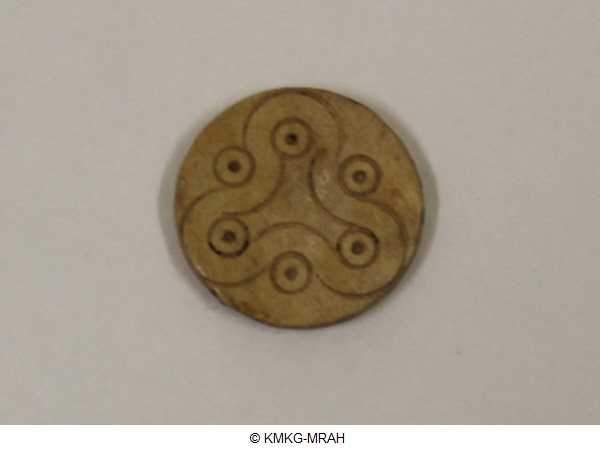
↑ , :
:
collectionName : Middle Ages and Modern TimesinventoryNb : B004917-006
objectName :
objectTitle :
objectCulture :
geography :
dating :
material :
technique :
dimensions : Diameter: 3,1 cm
legalRightOwner : Musées royaux d'art et d'histoire/Koninklijke Musea voor Kunst en Geschiedenis
objectDescription : The motte-and-bailey castle ‘Senecaberg’ (Grimbergen, Borgt) was first excavated by A. de Loë en A. Rutot (Société Royale d’Archéologie de Bruxelles) in 1890-1891. The first large-scale excavation campaign took place between 1966-1968 and was conducted by René Borremans (assistant of ME. Mariën, curator of the National Archaeology Department from 1957 to 1983). The site was founded in the last quarter of the 11th century by the Lords of Grimbergen and was taken in 1159 by Godfrey III, count of Leuven. In that same year the site was abandoned. In addition to a large amount of artefacts and bone-material, the excavators could document the foundations of different successive wooden structures on top of the mound.

↑ , :
:
collectionName : Middle Ages and Modern TimesinventoryNb : B004917-007
objectName :
objectTitle :
objectCulture :
geography :
dating :
material :
technique :
dimensions : Length: 5,6 cm
legalRightOwner : Musées royaux d'art et d'histoire/Koninklijke Musea voor Kunst en Geschiedenis
objectDescription : The motte-and-bailey castle ‘Senecaberg’ (Grimbergen, Borgt) was first excavated by A. de Loë en A. Rutot (Société Royale d’Archéologie de Bruxelles) in 1890-1891. The first large-scale excavation campaign took place between 1966-1968 and was conducted by René Borremans (assistant of ME. Mariën, curator of the National Archaeology Department from 1957 to 1983). The site was founded in the last quarter of the 11th century by the Lords of Grimbergen and was taken in 1159 by Godfrey III, count of Leuven. In that same year the site was abandoned. In addition to a large amount of artefacts and bone-material, the excavators could document the foundations of different successive wooden structures on top of the mound.
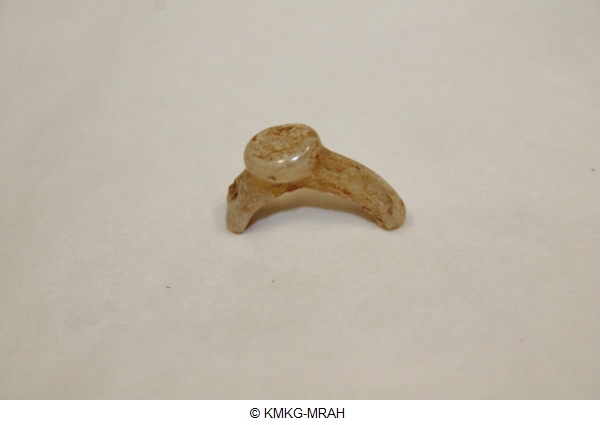
↑ , :
:
collectionName : Middle Ages and Modern TimesinventoryNb : B004917-008
objectName :
objectTitle :
objectCulture :
geography :
dating :
material :
technique :
dimensions :
legalRightOwner : Musées royaux d'art et d'histoire/Koninklijke Musea voor Kunst en Geschiedenis
objectDescription : The motte-and-bailey castle ‘Senecaberg’ (Grimbergen, Borgt) was first excavated by A. de Loë en A. Rutot (Société Royale d’Archéologie de Bruxelles) in 1890-1891. The first large-scale excavation campaign took place between 1966-1968 and was conducted by René Borremans (assistant of ME. Mariën, curator of the National Archaeology Department from 1957 to 1983). The site was founded in the last quarter of the 11th century by the Lords of Grimbergen and was taken in 1159 by Godfrey III, count of Leuven. In that same year the site was abandoned. In addition to a large amount of artefacts and bone-material, the excavators could document the foundations of different successive wooden structures on top of the mound.

↑ , :
:
collectionName : Middle Ages and Modern TimesinventoryNb : B004917-009
objectName :
objectTitle :
objectCulture :
geography :
dating :
material :
technique :
dimensions : Length: 13,6 cm
legalRightOwner : Musées royaux d'art et d'histoire/Koninklijke Musea voor Kunst en Geschiedenis
objectDescription : The motte-and-bailey castle ‘Senecaberg’ (Grimbergen, Borgt) was first excavated by A. de Loë en A. Rutot (Société Royale d’Archéologie de Bruxelles) in 1890-1891. The first large-scale excavation campaign took place between 1966-1968 and was conducted by René Borremans (assistant of ME. Mariën, curator of the National Archaeology Department from 1957 to 1983). The site was founded in the last quarter of the 11th century by the Lords of Grimbergen and was taken in 1159 by Godfrey III, count of Leuven. In that same year the site was abandoned. In addition to a large amount of artefacts and bone-material, the excavators could document the foundations of different successive wooden structures on top of the mound.

↑ , :
:
collectionName : Middle Ages and Modern TimesinventoryNb : B004917-010
objectName :
objectTitle :
objectCulture :
geography :
dating :
material :
technique :
dimensions :
legalRightOwner : Musées royaux d'art et d'histoire/Koninklijke Musea voor Kunst en Geschiedenis
objectDescription : The motte-and-bailey castle ‘Senecaberg’ (Grimbergen, Borgt) was first excavated by A. de Loë en A. Rutot (Société Royale d’Archéologie de Bruxelles) in 1890-1891. The first large-scale excavation campaign took place between 1966-1968 and was conducted by René Borremans (assistant of ME. Mariën, curator of the National Archaeology Department from 1957 to 1983). The site was founded in the last quarter of the 11th century by the Lords of Grimbergen and was taken in 1159 by Godfrey III, count of Leuven. In that same year the site was abandoned. In addition to a large amount of artefacts and bone-material, the excavators could document the foundations of different successive wooden structures on top of the mound.
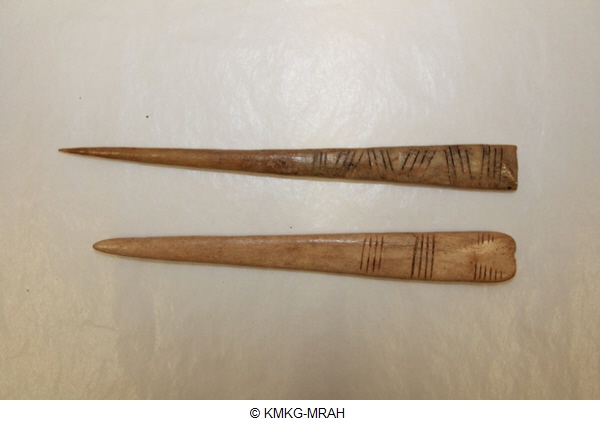
↑ , :
:
collectionName : Middle Ages and Modern TimesinventoryNb : B004917-011
objectName :
objectTitle :
objectCulture :
geography :
dating :
material :
technique :
dimensions : Length: 12,6 cm
legalRightOwner : Musées royaux d'art et d'histoire/Koninklijke Musea voor Kunst en Geschiedenis
objectDescription : The motte-and-bailey castle ‘Senecaberg’ (Grimbergen, Borgt) was first excavated by A. de Loë en A. Rutot (Société Royale d’Archéologie de Bruxelles) in 1890-1891. The first large-scale excavation campaign took place between 1966-1968 and was conducted by René Borremans (assistant of ME. Mariën, curator of the National Archaeology Department from 1957 to 1983). The site was founded in the last quarter of the 11th century by the Lords of Grimbergen and was taken in 1159 by Godfrey III, count of Leuven. In that same year the site was abandoned. In addition to a large amount of artefacts and bone-material, the excavators could document the foundations of different successive wooden structures on top of the mound.

↑ , :
:
collectionName : Middle Ages and Modern TimesinventoryNb : B004917-012
objectName :
objectTitle :
objectCulture :
geography :
dating :
material :
technique :
dimensions :
legalRightOwner : Musées royaux d'art et d'histoire/Koninklijke Musea voor Kunst en Geschiedenis
objectDescription : The motte-and-bailey castle ‘Senecaberg’ (Grimbergen, Borgt) was first excavated by A. de Loë en A. Rutot (Société Royale d’Archéologie de Bruxelles) in 1890-1891. The first large-scale excavation campaign took place between 1966-1968 and was conducted by René Borremans (assistant of ME. Mariën, curator of the National Archaeology Department from 1957 to 1983). The site was founded in the last quarter of the 11th century by the Lords of Grimbergen and was taken in 1159 by Godfrey III, count of Leuven. In that same year the site was abandoned. In addition to a large amount of artefacts and bone-material, the excavators could document the foundations of different successive wooden structures on top of the mound.

↑ , :
:
collectionName : Middle Ages and Modern TimesinventoryNb : B004917-013
objectName :
objectTitle :
objectCulture :
geography :
dating :
material :
technique :
dimensions :
legalRightOwner : Musées royaux d'art et d'histoire/Koninklijke Musea voor Kunst en Geschiedenis
objectDescription : The motte-and-bailey castle ‘Senecaberg’ (Grimbergen, Borgt) was first excavated by A. de Loë en A. Rutot (Société Royale d’Archéologie de Bruxelles) in 1890-1891. The first large-scale excavation campaign took place between 1966-1968 and was conducted by René Borremans (assistant of ME. Mariën, curator of the National Archaeology Department from 1957 to 1983). The site was founded in the last quarter of the 11th century by the Lords of Grimbergen and was taken in 1159 by Godfrey III, count of Leuven. In that same year the site was abandoned. In addition to a large amount of artefacts and bone-material, the excavators could document the foundations of different successive wooden structures on top of the mound.

↑ , :
:
collectionName : Middle Ages and Modern TimesinventoryNb : B004917-014
objectName :
objectTitle :
objectCulture :
geography :
dating :
material :
technique :
dimensions :
legalRightOwner : Musées royaux d'art et d'histoire/Koninklijke Musea voor Kunst en Geschiedenis
objectDescription : The motte-and-bailey castle ‘Senecaberg’ (Grimbergen, Borgt) was first excavated by A. de Loë en A. Rutot (Société Royale d’Archéologie de Bruxelles) in 1890-1891. The first large-scale excavation campaign took place between 1966-1968 and was conducted by René Borremans (assistant of ME. Mariën, curator of the National Archaeology Department from 1957 to 1983). The site was founded in the last quarter of the 11th century by the Lords of Grimbergen and was taken in 1159 by Godfrey III, count of Leuven. In that same year the site was abandoned. In addition to a large amount of artefacts and bone-material, the excavators could document the foundations of different successive wooden structures on top of the mound.
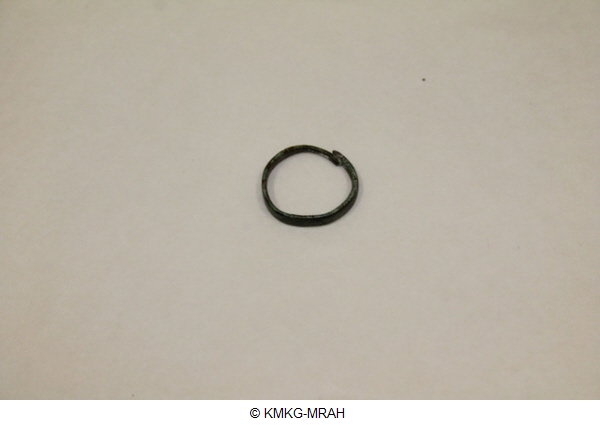
↑ , :
:
collectionName : Middle Ages and Modern TimesinventoryNb : B004917-015
objectName :
objectTitle :
objectCulture :
geography :
dating :
material :
technique :
dimensions : Diameter: 1,8 cm
legalRightOwner : Musées royaux d'art et d'histoire/Koninklijke Musea voor Kunst en Geschiedenis
objectDescription : The motte-and-bailey castle ‘Senecaberg’ (Grimbergen, Borgt) was first excavated by A. de Loë en A. Rutot (Société Royale d’Archéologie de Bruxelles) in 1890-1891. The first large-scale excavation campaign took place between 1966-1968 and was conducted by René Borremans (assistant of ME. Mariën, curator of the National Archaeology Department from 1957 to 1983). The site was founded in the last quarter of the 11th century by the Lords of Grimbergen and was taken in 1159 by Godfrey III, count of Leuven. In that same year the site was abandoned. In addition to a large amount of artefacts and bone-material, the excavators could document the foundations of different successive wooden structures on top of the mound.

↑ , :
:
collectionName : Middle Ages and Modern TimesinventoryNb : B004917-016
objectName :
objectTitle :
objectCulture :
geography :
dating :
material :
technique :
dimensions :
legalRightOwner : Musées royaux d'art et d'histoire/Koninklijke Musea voor Kunst en Geschiedenis
objectDescription : The motte-and-bailey castle ‘Senecaberg’ (Grimbergen, Borgt) was first excavated by A. de Loë en A. Rutot (Société Royale d’Archéologie de Bruxelles) in 1890-1891. The first large-scale excavation campaign took place between 1966-1968 and was conducted by René Borremans (assistant of ME. Mariën, curator of the National Archaeology Department from 1957 to 1983). The site was founded in the last quarter of the 11th century by the Lords of Grimbergen and was taken in 1159 by Godfrey III, count of Leuven. In that same year the site was abandoned. In addition to a large amount of artefacts and bone-material, the excavators could document the foundations of different successive wooden structures on top of the mound.

↑ , :
:
collectionName : Middle Ages and Modern TimesinventoryNb : B004917-017
objectName :
objectTitle :
objectCulture :
geography :
dating :
material :
technique :
dimensions :
legalRightOwner : Musées royaux d'art et d'histoire/Koninklijke Musea voor Kunst en Geschiedenis
objectDescription : The motte-and-bailey castle ‘Senecaberg’ (Grimbergen, Borgt) was first excavated by A. de Loë en A. Rutot (Société Royale d’Archéologie de Bruxelles) in 1890-1891. The first large-scale excavation campaign took place between 1966-1968 and was conducted by René Borremans (assistant of ME. Mariën, curator of the National Archaeology Department from 1957 to 1983). The site was founded in the last quarter of the 11th century by the Lords of Grimbergen and was taken in 1159 by Godfrey III, count of Leuven. In that same year the site was abandoned. In addition to a large amount of artefacts and bone-material, the excavators could document the foundations of different successive wooden structures on top of the mound.
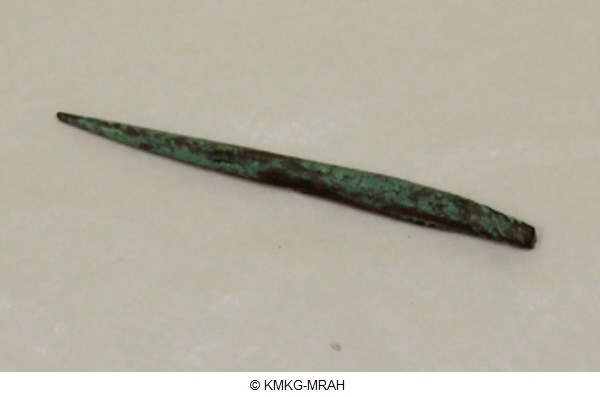
↑ , :
:
collectionName : Middle Ages and Modern TimesinventoryNb : B004917-019
objectName :
objectTitle :
objectCulture :
geography :
dating :
material :
technique :
dimensions : Length: 6,2 cm
legalRightOwner : Musées royaux d'art et d'histoire/Koninklijke Musea voor Kunst en Geschiedenis
objectDescription : The motte-and-bailey castle ‘Senecaberg’ (Grimbergen, Borgt) was first excavated by A. de Loë en A. Rutot (Société Royale d’Archéologie de Bruxelles) in 1890-1891. The first large-scale excavation campaign took place between 1966-1968 and was conducted by René Borremans (assistant of ME. Mariën, curator of the National Archaeology Department from 1957 to 1983). The site was founded in the last quarter of the 11th century by the Lords of Grimbergen and was taken in 1159 by Godfrey III, count of Leuven. In that same year the site was abandoned. In addition to a large amount of artefacts and bone-material, the excavators could document the foundations of different successive wooden structures on top of the mound.

↑ , :
:
collectionName : Middle Ages and Modern TimesinventoryNb : B004917-020
objectName :
objectTitle :
objectCulture :
geography :
dating :
material :
technique :
dimensions :
legalRightOwner : Musées royaux d'art et d'histoire/Koninklijke Musea voor Kunst en Geschiedenis
objectDescription : The motte-and-bailey castle ‘Senecaberg’ (Grimbergen, Borgt) was first excavated by A. de Loë en A. Rutot (Société Royale d’Archéologie de Bruxelles) in 1890-1891. The first large-scale excavation campaign took place between 1966-1968 and was conducted by René Borremans (assistant of ME. Mariën, curator of the National Archaeology Department from 1957 to 1983). The site was founded in the last quarter of the 11th century by the Lords of Grimbergen and was taken in 1159 by Godfrey III, count of Leuven. In that same year the site was abandoned. In addition to a large amount of artefacts and bone-material, the excavators could document the foundations of different successive wooden structures on top of the mound.

↑ , :
:
collectionName : Middle Ages and Modern TimesinventoryNb : B004917-021
objectName :
objectTitle :
objectCulture :
geography :
dating :
material :
technique :
dimensions : Length: 11,3 cm
legalRightOwner : Musées royaux d'art et d'histoire/Koninklijke Musea voor Kunst en Geschiedenis
objectDescription : The motte-and-bailey castle ‘Senecaberg’ (Grimbergen, Borgt) was first excavated by A. de Loë en A. Rutot (Société Royale d’Archéologie de Bruxelles) in 1890-1891. The first large-scale excavation campaign took place between 1966-1968 and was conducted by René Borremans (assistant of ME. Mariën, curator of the National Archaeology Department from 1957 to 1983). The site was founded in the last quarter of the 11th century by the Lords of Grimbergen and was taken in 1159 by Godfrey III, count of Leuven. In that same year the site was abandoned. In addition to a large amount of artefacts and bone-material, the excavators could document the foundations of different successive wooden structures on top of the mound.
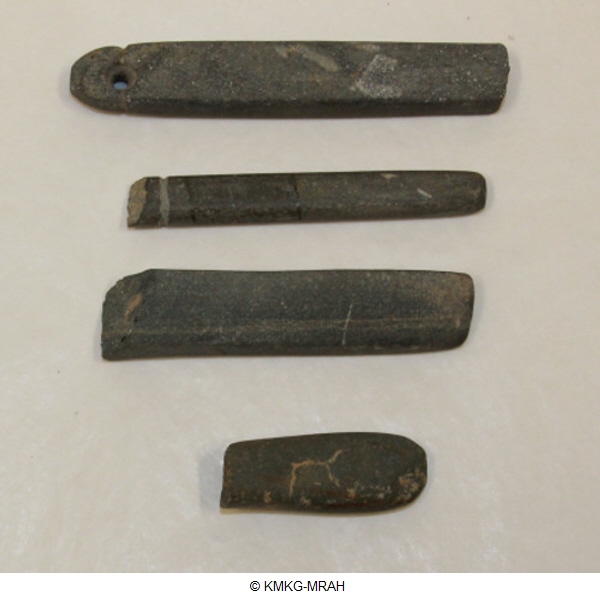
↑ , :
:
collectionName : Middle Ages and Modern TimesinventoryNb : B004917-022
objectName :
objectTitle :
objectCulture :
geography :
dating :
material :
technique :
dimensions :
legalRightOwner : Musées royaux d'art et d'histoire/Koninklijke Musea voor Kunst en Geschiedenis
objectDescription : The motte-and-bailey castle ‘Senecaberg’ (Grimbergen, Borgt) was first excavated by A. de Loë en A. Rutot (Société Royale d’Archéologie de Bruxelles) in 1890-1891. The first large-scale excavation campaign took place between 1966-1968 and was conducted by René Borremans (assistant of ME. Mariën, curator of the National Archaeology Department from 1957 to 1983). The site was founded in the last quarter of the 11th century by the Lords of Grimbergen and was taken in 1159 by Godfrey III, count of Leuven. In that same year the site was abandoned. In addition to a large amount of artefacts and bone-material, the excavators could document the foundations of different successive wooden structures on top of the mound.
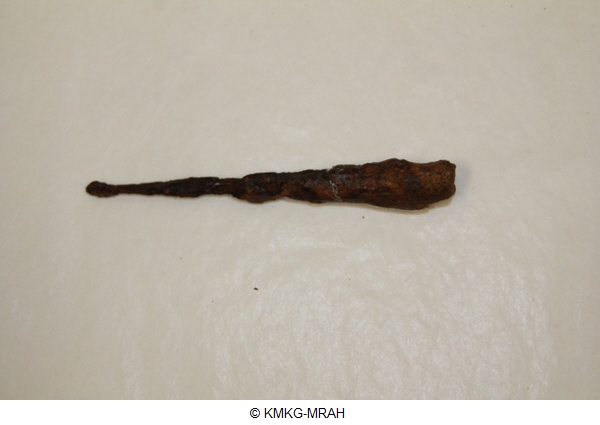
↑ , :
:
collectionName : Middle Ages and Modern TimesinventoryNb : B004917-023
objectName :
objectTitle :
objectCulture :
geography :
dating :
material :
technique :
dimensions : Length: 9,4 cm
legalRightOwner : Musées royaux d'art et d'histoire/Koninklijke Musea voor Kunst en Geschiedenis
objectDescription : The motte-and-bailey castle ‘Senecaberg’ (Grimbergen, Borgt) was first excavated by A. de Loë en A. Rutot (Société Royale d’Archéologie de Bruxelles) in 1890-1891. The first large-scale excavation campaign took place between 1966-1968 and was conducted by René Borremans (assistant of ME. Mariën, curator of the National Archaeology Department from 1957 to 1983). The site was founded in the last quarter of the 11th century by the Lords of Grimbergen and was taken in 1159 by Godfrey III, count of Leuven. In that same year the site was abandoned. In addition to a large amount of artefacts and bone-material, the excavators could document the foundations of different successive wooden structures on top of the mound.
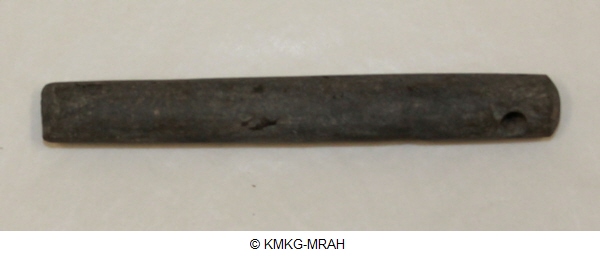
↑ , :
:
collectionName : Middle Ages and Modern TimesinventoryNb : B004917-024
objectName :
objectTitle :
objectCulture :
geography :
dating :
material :
technique :
dimensions : Length: 11,9 cm
legalRightOwner : Musées royaux d'art et d'histoire/Koninklijke Musea voor Kunst en Geschiedenis
objectDescription : The motte-and-bailey castle ‘Senecaberg’ (Grimbergen, Borgt) was first excavated by A. de Loë en A. Rutot (Société Royale d’Archéologie de Bruxelles) in 1890-1891. The first large-scale excavation campaign took place between 1966-1968 and was conducted by René Borremans (assistant of ME. Mariën, curator of the National Archaeology Department from 1957 to 1983). The site was founded in the last quarter of the 11th century by the Lords of Grimbergen and was taken in 1159 by Godfrey III, count of Leuven. In that same year the site was abandoned. In addition to a large amount of artefacts and bone-material, the excavators could document the foundations of different successive wooden structures on top of the mound.

↑ , :
:
collectionName : Middle Ages and Modern TimesinventoryNb : B004917-025
objectName :
objectTitle :
objectCulture :
geography :
dating :
material :
technique :
dimensions :
legalRightOwner : Musées royaux d'art et d'histoire/Koninklijke Musea voor Kunst en Geschiedenis
objectDescription : The motte-and-bailey castle ‘Senecaberg’ (Grimbergen, Borgt) was first excavated by A. de Loë en A. Rutot (Société Royale d’Archéologie de Bruxelles) in 1890-1891. The first large-scale excavation campaign took place between 1966-1968 and was conducted by René Borremans (assistant of ME. Mariën, curator of the National Archaeology Department from 1957 to 1983). The site was founded in the last quarter of the 11th century by the Lords of Grimbergen and was taken in 1159 by Godfrey III, count of Leuven. In that same year the site was abandoned. In addition to a large amount of artefacts and bone-material, the excavators could document the foundations of different successive wooden structures on top of the mound.

↑ , :
:
collectionName : Middle Ages and Modern TimesinventoryNb : B004917-026
objectName :
objectTitle :
objectCulture :
geography :
dating :
material :
technique :
dimensions : Length: 13,6 cm
legalRightOwner : Musées royaux d'art et d'histoire/Koninklijke Musea voor Kunst en Geschiedenis
objectDescription : The motte-and-bailey castle ‘Senecaberg’ (Grimbergen, Borgt) was first excavated by A. de Loë en A. Rutot (Société Royale d’Archéologie de Bruxelles) in 1890-1891. The first large-scale excavation campaign took place between 1966-1968 and was conducted by René Borremans (assistant of ME. Mariën, curator of the National Archaeology Department from 1957 to 1983). The site was founded in the last quarter of the 11th century by the Lords of Grimbergen and was taken in 1159 by Godfrey III, count of Leuven. In that same year the site was abandoned. In addition to a large amount of artefacts and bone-material, the excavators could document the foundations of different successive wooden structures on top of the mound.

↑ , :
:
collectionName : Middle Ages and Modern TimesinventoryNb : B004917-027
objectName :
objectTitle :
objectCulture :
geography :
dating :
material :
technique :
dimensions :
legalRightOwner : Musées royaux d'art et d'histoire/Koninklijke Musea voor Kunst en Geschiedenis
objectDescription : The motte-and-bailey castle ‘Senecaberg’ (Grimbergen, Borgt) was first excavated by A. de Loë en A. Rutot (Société Royale d’Archéologie de Bruxelles) in 1890-1891. The first large-scale excavation campaign took place between 1966-1968 and was conducted by René Borremans (assistant of ME. Mariën, curator of the National Archaeology Department from 1957 to 1983). The site was founded in the last quarter of the 11th century by the Lords of Grimbergen and was taken in 1159 by Godfrey III, count of Leuven. In that same year the site was abandoned. In addition to a large amount of artefacts and bone-material, the excavators could document the foundations of different successive wooden structures on top of the mound.
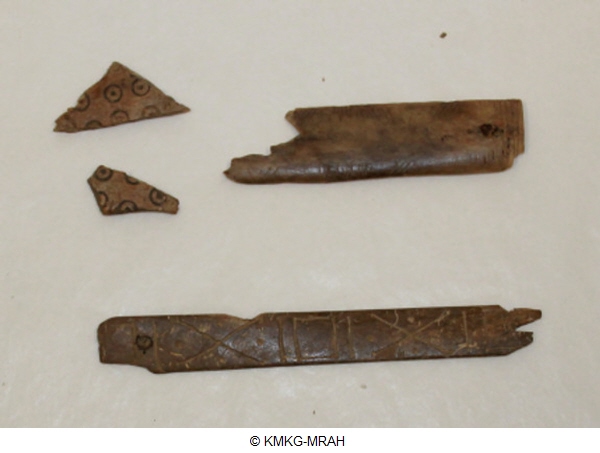
↑ , :
:
collectionName : Middle Ages and Modern TimesinventoryNb : B004917-028
objectName :
objectTitle :
objectCulture :
geography :
dating :
material :
technique :
dimensions :
legalRightOwner : Musées royaux d'art et d'histoire/Koninklijke Musea voor Kunst en Geschiedenis
objectDescription : The motte-and-bailey castle ‘Senecaberg’ (Grimbergen, Borgt) was first excavated by A. de Loë en A. Rutot (Société Royale d’Archéologie de Bruxelles) in 1890-1891. The first large-scale excavation campaign took place between 1966-1968 and was conducted by René Borremans (assistant of ME. Mariën, curator of the National Archaeology Department from 1957 to 1983). The site was founded in the last quarter of the 11th century by the Lords of Grimbergen and was taken in 1159 by Godfrey III, count of Leuven. In that same year the site was abandoned. In addition to a large amount of artefacts and bone-material, the excavators could document the foundations of different successive wooden structures on top of the mound.
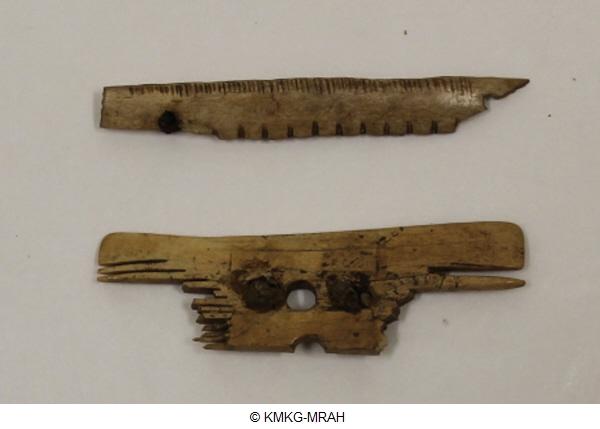
↑ , :
:
collectionName : Middle Ages and Modern TimesinventoryNb : B004917-029
objectName :
objectTitle :
objectCulture :
geography :
dating :
material :
technique :
dimensions : Length: 9,4 cm
legalRightOwner : Musées royaux d'art et d'histoire/Koninklijke Musea voor Kunst en Geschiedenis
objectDescription : The motte-and-bailey castle ‘Senecaberg’ (Grimbergen, Borgt) was first excavated by A. de Loë en A. Rutot (Société Royale d’Archéologie de Bruxelles) in 1890-1891. The first large-scale excavation campaign took place between 1966-1968 and was conducted by René Borremans (assistant of ME. Mariën, curator of the National Archaeology Department from 1957 to 1983). The site was founded in the last quarter of the 11th century by the Lords of Grimbergen and was taken in 1159 by Godfrey III, count of Leuven. In that same year the site was abandoned. In addition to a large amount of artefacts and bone-material, the excavators could document the foundations of different successive wooden structures on top of the mound.
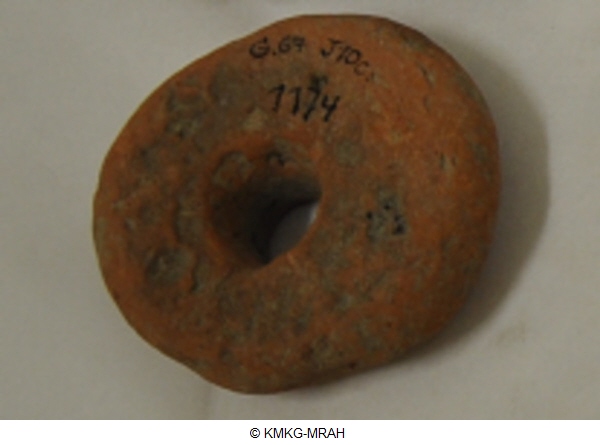
↑ , :
:
collectionName : Middle Ages and Modern TimesinventoryNb : B004917-030
objectName :
objectTitle :
objectCulture :
geography :
dating :
material :
technique :
dimensions : Diameter: 5,7 cm
legalRightOwner : Musées royaux d'art et d'histoire/Koninklijke Musea voor Kunst en Geschiedenis
objectDescription : The motte-and-bailey castle ‘Senecaberg’ (Grimbergen, Borgt) was first excavated by A. de Loë en A. Rutot (Société Royale d’Archéologie de Bruxelles) in 1890-1891. The first large-scale excavation campaign took place between 1966-1968 and was conducted by René Borremans (assistant of ME. Mariën, curator of the National Archaeology Department from 1957 to 1983). The site was founded in the last quarter of the 11th century by the Lords of Grimbergen and was taken in 1159 by Godfrey III, count of Leuven. In that same year the site was abandoned. In addition to a large amount of artefacts and bone-material, the excavators could document the foundations of different successive wooden structures on top of the mound.

↑ , :
:
collectionName : Middle Ages and Modern TimesinventoryNb : B004917-031
objectName :
objectTitle :
objectCulture :
geography :
dating :
material :
technique :
dimensions :
legalRightOwner : Musées royaux d'art et d'histoire/Koninklijke Musea voor Kunst en Geschiedenis
objectDescription : The motte-and-bailey castle ‘Senecaberg’ (Grimbergen, Borgt) was first excavated by A. de Loë en A. Rutot (Société Royale d’Archéologie de Bruxelles) in 1890-1891. The first large-scale excavation campaign took place between 1966-1968 and was conducted by René Borremans (assistant of ME. Mariën, curator of the National Archaeology Department from 1957 to 1983). The site was founded in the last quarter of the 11th century by the Lords of Grimbergen and was taken in 1159 by Godfrey III, count of Leuven. In that same year the site was abandoned. In addition to a large amount of artefacts and bone-material, the excavators could document the foundations of different successive wooden structures on top of the mound.

↑ , :
:
collectionName : Middle Ages and Modern TimesinventoryNb : B004917-032
objectName :
objectTitle :
objectCulture :
geography :
dating :
material :
technique :
dimensions : Diameter: 2 cm
legalRightOwner : Musées royaux d'art et d'histoire/Koninklijke Musea voor Kunst en Geschiedenis
objectDescription : The motte-and-bailey castle ‘Senecaberg’ (Grimbergen, Borgt) was first excavated by A. de Loë en A. Rutot (Société Royale d’Archéologie de Bruxelles) in 1890-1891. The first large-scale excavation campaign took place between 1966-1968 and was conducted by René Borremans (assistant of ME. Mariën, curator of the National Archaeology Department from 1957 to 1983). The site was founded in the last quarter of the 11th century by the Lords of Grimbergen and was taken in 1159 by Godfrey III, count of Leuven. In that same year the site was abandoned. In addition to a large amount of artefacts and bone-material, the excavators could document the foundations of different successive wooden structures on top of the mound.

↑ , :
:
collectionName : Middle Ages and Modern TimesinventoryNb : B004917-033
objectName :
objectTitle :
objectCulture :
geography :
dating :
material :
technique :
dimensions : Length: 6,8 cm
legalRightOwner : Musées royaux d'art et d'histoire/Koninklijke Musea voor Kunst en Geschiedenis
objectDescription : The motte-and-bailey castle ‘Senecaberg’ (Grimbergen, Borgt) was first excavated by A. de Loë en A. Rutot (Société Royale d’Archéologie de Bruxelles) in 1890-1891. The first large-scale excavation campaign took place between 1966-1968 and was conducted by René Borremans (assistant of ME. Mariën, curator of the National Archaeology Department from 1957 to 1983). The site was founded in the last quarter of the 11th century by the Lords of Grimbergen and was taken in 1159 by Godfrey III, count of Leuven. In that same year the site was abandoned. In addition to a large amount of artefacts and bone-material, the excavators could document the foundations of different successive wooden structures on top of the mound.

↑ , :
:
collectionName : Middle Ages and Modern TimesinventoryNb : B004917-034
objectName :
objectTitle :
objectCulture :
geography :
dating :
material :
technique :
dimensions : Length: 1,5 cm, Width: 1,3 cm
legalRightOwner : Musées royaux d'art et d'histoire/Koninklijke Musea voor Kunst en Geschiedenis
objectDescription : The motte-and-bailey castle ‘Senecaberg’ (Grimbergen, Borgt) was first excavated by A. de Loë en A. Rutot (Société Royale d’Archéologie de Bruxelles) in 1890-1891. The first large-scale excavation campaign took place between 1966-1968 and was conducted by René Borremans (assistant of ME. Mariën, curator of the National Archaeology Department from 1957 to 1983). The site was founded in the last quarter of the 11th century by the Lords of Grimbergen and was taken in 1159 by Godfrey III, count of Leuven. In that same year the site was abandoned. In addition to a large amount of artefacts and bone-material, the excavators could document the foundations of different successive wooden structures on top of the mound.

↑ , :
:
collectionName : Middle Ages and Modern TimesinventoryNb : B004917-036
objectName :
objectTitle :
objectCulture :
geography :
dating :
material :
technique :
dimensions : Length: 8,2 cm
legalRightOwner : Musées royaux d'art et d'histoire/Koninklijke Musea voor Kunst en Geschiedenis
objectDescription : The motte-and-bailey castle ‘Senecaberg’ (Grimbergen, Borgt) was first excavated by A. de Loë en A. Rutot (Société Royale d’Archéologie de Bruxelles) in 1890-1891. The first large-scale excavation campaign took place between 1966-1968 and was conducted by René Borremans (assistant of ME. Mariën, curator of the National Archaeology Department from 1957 to 1983). The site was founded in the last quarter of the 11th century by the Lords of Grimbergen and was taken in 1159 by Godfrey III, count of Leuven. In that same year the site was abandoned. In addition to a large amount of artefacts and bone-material, the excavators could document the foundations of different successive wooden structures on top of the mound.

↑ , :
:
collectionName : Middle Ages and Modern TimesinventoryNb : B004917-037
objectName :
objectTitle :
objectCulture :
geography :
dating :
material :
technique :
dimensions :
legalRightOwner : Musées royaux d'art et d'histoire/Koninklijke Musea voor Kunst en Geschiedenis
objectDescription : The motte-and-bailey castle ‘Senecaberg’ (Grimbergen, Borgt) was first excavated by A. de Loë en A. Rutot (Société Royale d’Archéologie de Bruxelles) in 1890-1891. The first large-scale excavation campaign took place between 1966-1968 and was conducted by René Borremans (assistant of ME. Mariën, curator of the National Archaeology Department from 1957 to 1983). The site was founded in the last quarter of the 11th century by the Lords of Grimbergen and was taken in 1159 by Godfrey III, count of Leuven. In that same year the site was abandoned. In addition to a large amount of artefacts and bone-material, the excavators could document the foundations of different successive wooden structures on top of the mound.

↑ , :
:
collectionName : Middle Ages and Modern TimesinventoryNb : B004917-038
objectName :
objectTitle :
objectCulture :
geography :
dating :
material :
technique :
dimensions :
legalRightOwner : Musées royaux d'art et d'histoire/Koninklijke Musea voor Kunst en Geschiedenis
objectDescription : The motte-and-bailey castle ‘Senecaberg’ (Grimbergen, Borgt) was first excavated by A. de Loë en A. Rutot (Société Royale d’Archéologie de Bruxelles) in 1890-1891. The first large-scale excavation campaign took place between 1966-1968 and was conducted by René Borremans (assistant of ME. Mariën, curator of the National Archaeology Department from 1957 to 1983). The site was founded in the last quarter of the 11th century by the Lords of Grimbergen and was taken in 1159 by Godfrey III, count of Leuven. In that same year the site was abandoned. In addition to a large amount of artefacts and bone-material, the excavators could document the foundations of different successive wooden structures on top of the mound.
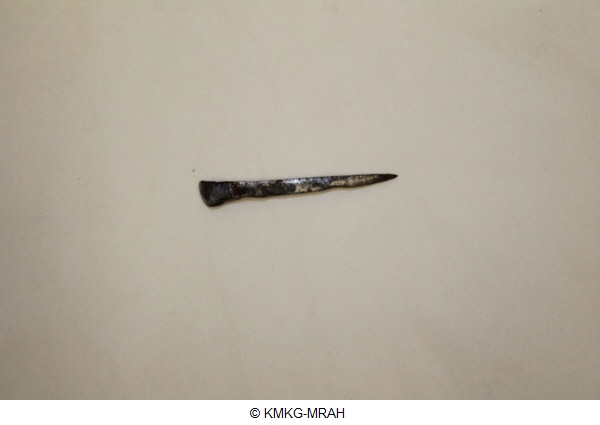
↑ , :
:
collectionName : Middle Ages and Modern TimesinventoryNb : B004917-039
objectName :
objectTitle :
objectCulture :
geography :
dating :
material :
technique :
dimensions : Length: 4,6 cm
legalRightOwner : Musées royaux d'art et d'histoire/Koninklijke Musea voor Kunst en Geschiedenis
objectDescription : The motte-and-bailey castle ‘Senecaberg’ (Grimbergen, Borgt) was first excavated by A. de Loë en A. Rutot (Société Royale d’Archéologie de Bruxelles) in 1890-1891. The first large-scale excavation campaign took place between 1966-1968 and was conducted by René Borremans (assistant of ME. Mariën, curator of the National Archaeology Department from 1957 to 1983). The site was founded in the last quarter of the 11th century by the Lords of Grimbergen and was taken in 1159 by Godfrey III, count of Leuven. In that same year the site was abandoned. In addition to a large amount of artefacts and bone-material, the excavators could document the foundations of different successive wooden structures on top of the mound.
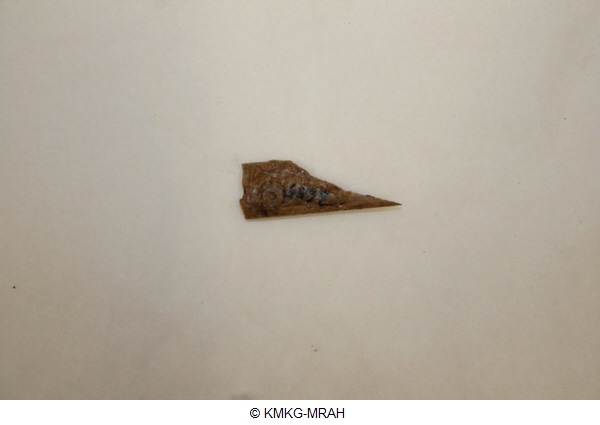
↑ , :
:
collectionName : Middle Ages and Modern TimesinventoryNb : B004917-040
objectName :
objectTitle :
objectCulture :
geography :
dating :
material :
technique :
dimensions :
legalRightOwner : Musées royaux d'art et d'histoire/Koninklijke Musea voor Kunst en Geschiedenis
objectDescription : The motte-and-bailey castle ‘Senecaberg’ (Grimbergen, Borgt) was first excavated by A. de Loë en A. Rutot (Société Royale d’Archéologie de Bruxelles) in 1890-1891. The first large-scale excavation campaign took place between 1966-1968 and was conducted by René Borremans (assistant of ME. Mariën, curator of the National Archaeology Department from 1957 to 1983). The site was founded in the last quarter of the 11th century by the Lords of Grimbergen and was taken in 1159 by Godfrey III, count of Leuven. In that same year the site was abandoned. In addition to a large amount of artefacts and bone-material, the excavators could document the foundations of different successive wooden structures on top of the mound.

↑ , :
:
collectionName : Middle Ages and Modern TimesinventoryNb : B004917-041
objectName :
objectTitle :
objectCulture :
geography :
dating :
material :
technique :
dimensions :
legalRightOwner : Musées royaux d'art et d'histoire/Koninklijke Musea voor Kunst en Geschiedenis
objectDescription : The motte-and-bailey castle ‘Senecaberg’ (Grimbergen, Borgt) was first excavated by A. de Loë en A. Rutot (Société Royale d’Archéologie de Bruxelles) in 1890-1891. The first large-scale excavation campaign took place between 1966-1968 and was conducted by René Borremans (assistant of ME. Mariën, curator of the National Archaeology Department from 1957 to 1983). The site was founded in the last quarter of the 11th century by the Lords of Grimbergen and was taken in 1159 by Godfrey III, count of Leuven. In that same year the site was abandoned. In addition to a large amount of artefacts and bone-material, the excavators could document the foundations of different successive wooden structures on top of the mound.

↑ , :
:
collectionName : Middle Ages and Modern TimesinventoryNb : B004917-042
objectName :
objectTitle :
objectCulture :
geography :
dating :
material :
technique :
dimensions :
legalRightOwner : Musées royaux d'art et d'histoire/Koninklijke Musea voor Kunst en Geschiedenis
objectDescription : The motte-and-bailey castle ‘Senecaberg’ (Grimbergen, Borgt) was first excavated by A. de Loë en A. Rutot (Société Royale d’Archéologie de Bruxelles) in 1890-1891. The first large-scale excavation campaign took place between 1966-1968 and was conducted by René Borremans (assistant of ME. Mariën, curator of the National Archaeology Department from 1957 to 1983). The site was founded in the last quarter of the 11th century by the Lords of Grimbergen and was taken in 1159 by Godfrey III, count of Leuven. In that same year the site was abandoned. In addition to a large amount of artefacts and bone-material, the excavators could document the foundations of different successive wooden structures on top of the mound.
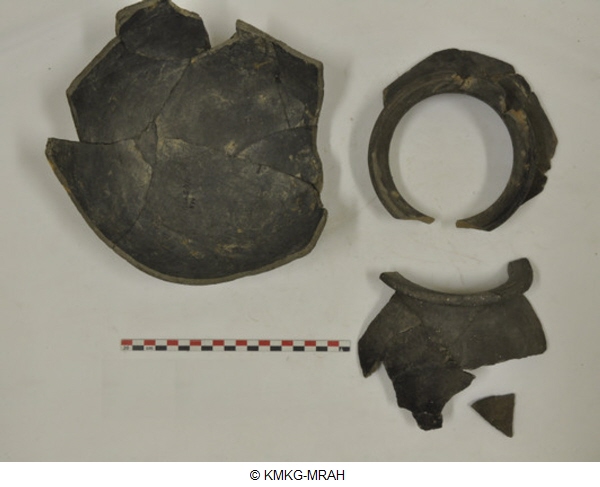
↑ , :
:
collectionName : Middle Ages and Modern TimesinventoryNb : B004917-043
objectName :
objectTitle :
objectCulture :
geography :
dating :
material :
technique :
dimensions :
legalRightOwner : Musées royaux d'art et d'histoire/Koninklijke Musea voor Kunst en Geschiedenis
objectDescription : The motte-and-bailey castle ‘Senecaberg’ (Grimbergen, Borgt) was first excavated by A. de Loë en A. Rutot (Société Royale d’Archéologie de Bruxelles) in 1890-1891. The first large-scale excavation campaign took place between 1966-1968 and was conducted by René Borremans (assistant of ME. Mariën, curator of the National Archaeology Department from 1957 to 1983). The site was founded in the last quarter of the 11th century by the Lords of Grimbergen and was taken in 1159 by Godfrey III, count of Leuven. In that same year the site was abandoned. In addition to a large amount of artefacts and bone-material, the excavators could document the foundations of different successive wooden structures on top of the mound.

↑ , :
:
collectionName : Middle Ages and Modern TimesinventoryNb : B004917-044
objectName :
objectTitle :
objectCulture :
geography :
dating :
material :
technique :
dimensions :
legalRightOwner : Musées royaux d'art et d'histoire/Koninklijke Musea voor Kunst en Geschiedenis
objectDescription : The motte-and-bailey castle ‘Senecaberg’ (Grimbergen, Borgt) was first excavated by A. de Loë en A. Rutot (Société Royale d’Archéologie de Bruxelles) in 1890-1891. The first large-scale excavation campaign took place between 1966-1968 and was conducted by René Borremans (assistant of ME. Mariën, curator of the National Archaeology Department from 1957 to 1983). The site was founded in the last quarter of the 11th century by the Lords of Grimbergen and was taken in 1159 by Godfrey III, count of Leuven. In that same year the site was abandoned. In addition to a large amount of artefacts and bone-material, the excavators could document the foundations of different successive wooden structures on top of the mound.
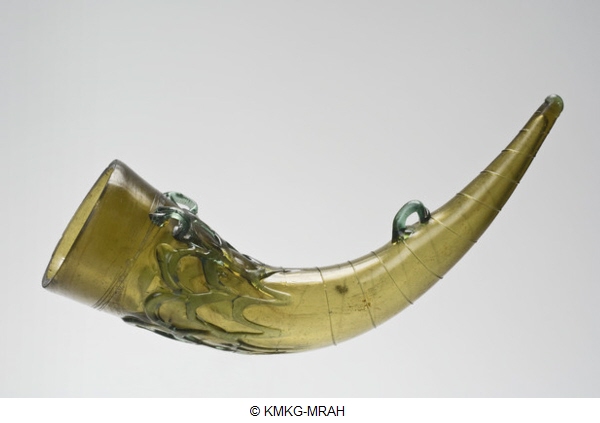
↑ , :
:
collectionName : MerovingiansinventoryNb : B005829-001
objectName :
objectTitle :
objectCulture : Merovingian
geography :
dating :
material :
technique :
dimensions : Height: 20,3 cm
legalRightOwner : Musées royaux d'art et d'histoire/Koninklijke Musea voor Kunst en Geschiedenis
objectDescription : In the early Middle Ages, people were buried with various grave goods. This drinking horn, acquired by the museum in 2010, is probably from the cemetery of Anderlecht, where it was unearthed during early excavations. Its previous owner discovered it as a child in the attic of his grandfather, a Brussels notary. A greenish yellow, heightened with a net pattern and three rings, all bluish green, it is distinctive for its large size. Related to similar net-decorated horns form Lombardy, it could nonetheless be a local product. Intact ancient or medieval glass drinking horns are quite rare.
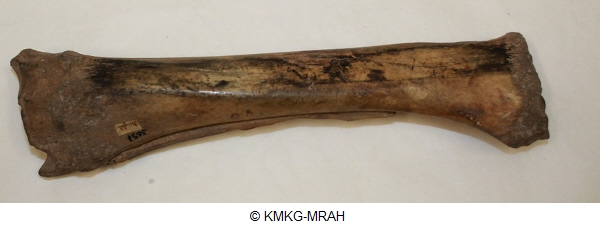
↑ , :
:
collectionName : Middle Ages and Modern TimesinventoryNb : D0095-001
objectName :
objectTitle :
objectCulture :
geography :
dating :
material :
technique :
dimensions : Length: 27,3 cm
legalRightOwner : Société Royale d'Archéologie de Bruxelles
objectDescription : The motte-and-bailey castle ‘Senecaberg’ (Grimbergen, Borgt) was first excavated by A. de Loë en A. Rutot (Société Royale d’Archéologie de Bruxelles) in 1890-1891. The first large-scale excavation campaign took place between 1966-1968 and was conducted by René Borremans (assistant of ME. Mariën, curator of the National Archaeology Department from 1957 to 1983). The site was founded in the last quarter of the 11th century by the Lords of Grimbergen and was taken in 1159 by Godfrey III, count of Leuven. In that same year the site was abandoned. In addition to a large amount of artefacts and bone-material, the excavators could document the foundations of different successive wooden structures on top of the mound.
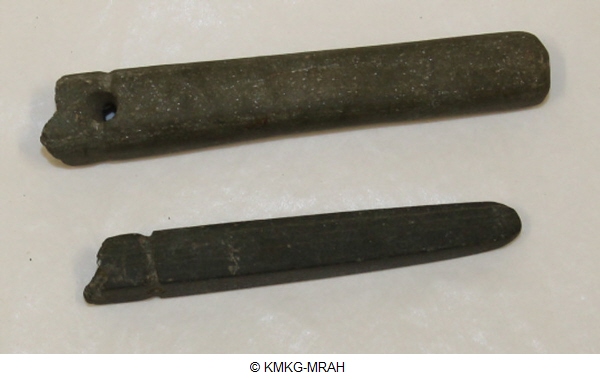
↑ , :
:
collectionName : Middle Ages and Modern TimesinventoryNb : D0095-002
objectName :
objectTitle :
objectCulture :
geography :
dating :
material :
technique :
dimensions : Length: 8,3 cm
legalRightOwner : Société Royale d'Archéologie de Bruxelles
objectDescription : The motte-and-bailey castle ‘Senecaberg’ (Grimbergen, Borgt) was first excavated by A. de Loë en A. Rutot (Société Royale d’Archéologie de Bruxelles) in 1890-1891. The first large-scale excavation campaign took place between 1966-1968 and was conducted by René Borremans (assistant of ME. Mariën, curator of the National Archaeology Department from 1957 to 1983). The site was founded in the last quarter of the 11th century by the Lords of Grimbergen and was taken in 1159 by Godfrey III, count of Leuven. In that same year the site was abandoned. In addition to a large amount of artefacts and bone-material, the excavators could document the foundations of different successive wooden structures on top of the mound.

↑ , :
:
collectionName : Middle Ages and Modern TimesinventoryNb : D0095-003
objectName :
objectTitle :
objectCulture :
geography :
dating :
material :
technique :
dimensions :
legalRightOwner : Société Royale d'Archéologie de Bruxelles
objectDescription : The motte-and-bailey castle ‘Senecaberg’ (Grimbergen, Borgt) was first excavated by A. de Loë en A. Rutot (Société Royale d’Archéologie de Bruxelles) in 1890-1891. The first large-scale excavation campaign took place between 1966-1968 and was conducted by René Borremans (assistant of ME. Mariën, curator of the National Archaeology Department from 1957 to 1983). The site was founded in the last quarter of the 11th century by the Lords of Grimbergen and was taken in 1159 by Godfrey III, count of Leuven. In that same year the site was abandoned. In addition to a large amount of artefacts and bone-material, the excavators could document the foundations of different successive wooden structures on top of the mound.
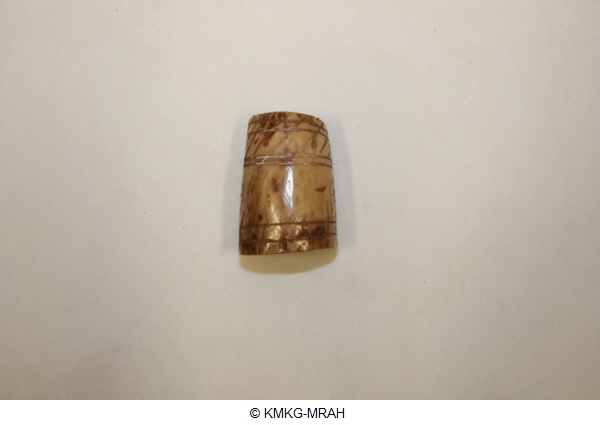
↑ , :
:
collectionName : Middle Ages and Modern TimesinventoryNb : D0095-004
objectName :
objectTitle :
objectCulture :
geography :
dating :
material :
technique :
dimensions : Length: 3,7 cm
legalRightOwner : Société Royale d'Archéologie de Bruxelles
objectDescription : The motte-and-bailey castle ‘Senecaberg’ (Grimbergen, Borgt) was first excavated by A. de Loë en A. Rutot (Société Royale d’Archéologie de Bruxelles) in 1890-1891. The first large-scale excavation campaign took place between 1966-1968 and was conducted by René Borremans (assistant of ME. Mariën, curator of the National Archaeology Department from 1957 to 1983). The site was founded in the last quarter of the 11th century by the Lords of Grimbergen and was taken in 1159 by Godfrey III, count of Leuven. In that same year the site was abandoned. In addition to a large amount of artefacts and bone-material, the excavators could document the foundations of different successive wooden structures on top of the mound.
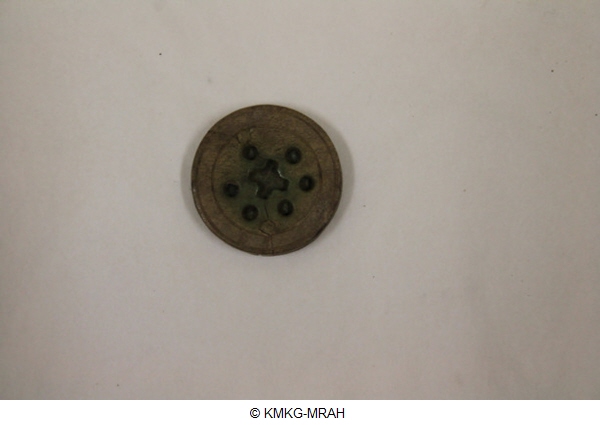
↑ , :
:
collectionName : Middle Ages and Modern TimesinventoryNb : D0095-005
objectName :
objectTitle :
objectCulture :
geography :
dating :
material :
technique :
dimensions : Diameter: 3,2 cm
legalRightOwner : Société Royale d'Archéologie de Bruxelles
objectDescription : The motte-and-bailey castle ‘Senecaberg’ (Grimbergen, Borgt) was first excavated by A. de Loë en A. Rutot (Société Royale d’Archéologie de Bruxelles) in 1890-1891. The first large-scale excavation campaign took place between 1966-1968 and was conducted by René Borremans (assistant of ME. Mariën, curator of the National Archaeology Department from 1957 to 1983). The site was founded in the last quarter of the 11th century by the Lords of Grimbergen and was taken in 1159 by Godfrey III, count of Leuven. In that same year the site was abandoned. In addition to a large amount of artefacts and bone-material, the excavators could document the foundations of different successive wooden structures on top of the mound.
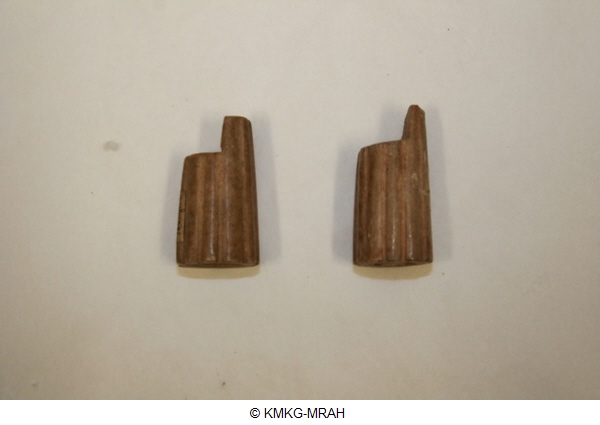
↑ , :
:
collectionName : Middle Ages and Modern TimesinventoryNb : D0095-006
objectName :
objectTitle :
objectCulture :
geography :
dating :
material :
technique :
dimensions : Height: 3,7 cm
legalRightOwner : Société Royale d'Archéologie de Bruxelles
objectDescription : The motte-and-bailey castle ‘Senecaberg’ (Grimbergen, Borgt) was first excavated by A. de Loë en A. Rutot (Société Royale d’Archéologie de Bruxelles) in 1890-1891. The first large-scale excavation campaign took place between 1966-1968 and was conducted by René Borremans (assistant of ME. Mariën, curator of the National Archaeology Department from 1957 to 1983). The site was founded in the last quarter of the 11th century by the Lords of Grimbergen and was taken in 1159 by Godfrey III, count of Leuven. In that same year the site was abandoned. In addition to a large amount of artefacts and bone-material, the excavators could document the foundations of different successive wooden structures on top of the mound.
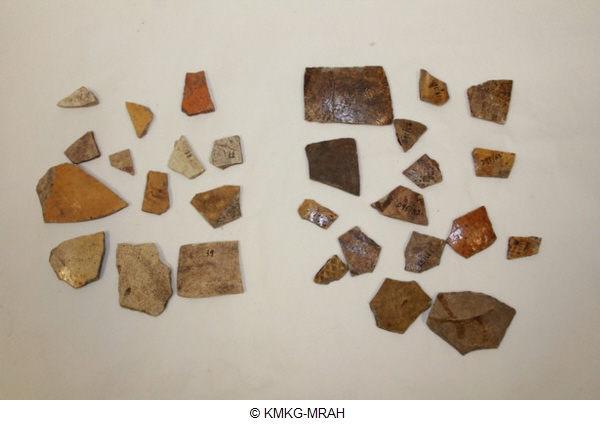
↑ , :
:
collectionName : Middle Ages and Modern TimesinventoryNb : D0095-007
objectName :
objectTitle :
objectCulture :
geography :
dating :
material :
technique :
dimensions :
legalRightOwner : Société Royale d'Archéologie de Bruxelles
objectDescription : The motte-and-bailey castle ‘Senecaberg’ (Grimbergen, Borgt) was first excavated by A. de Loë en A. Rutot (Société Royale d’Archéologie de Bruxelles) in 1890-1891. The first large-scale excavation campaign took place between 1966-1968 and was conducted by René Borremans (assistant of ME. Mariën, curator of the National Archaeology Department from 1957 to 1983). The site was founded in the last quarter of the 11th century by the Lords of Grimbergen and was taken in 1159 by Godfrey III, count of Leuven. In that same year the site was abandoned. In addition to a large amount of artefacts and bone-material, the excavators could document the foundations of different successive wooden structures on top of the mound.
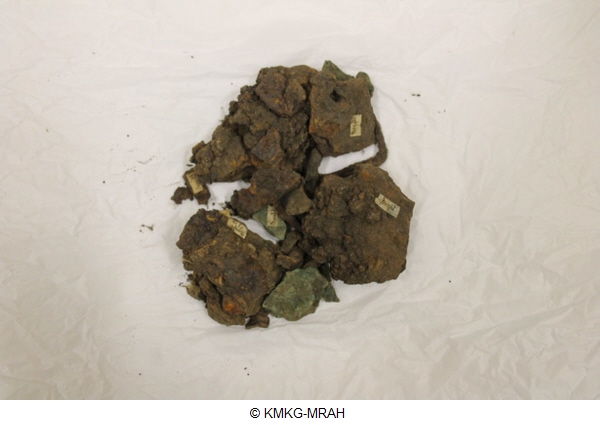
↑ , :
:
collectionName : Middle Ages and Modern TimesinventoryNb : D0095-008
objectName :
objectTitle :
objectCulture :
geography :
dating :
material :
technique :
dimensions :
legalRightOwner : Société Royale d'Archéologie de Bruxelles
objectDescription : The motte-and-bailey castle ‘Senecaberg’ (Grimbergen, Borgt) was first excavated by A. de Loë en A. Rutot (Société Royale d’Archéologie de Bruxelles) in 1890-1891. The first large-scale excavation campaign took place between 1966-1968 and was conducted by René Borremans (assistant of ME. Mariën, curator of the National Archaeology Department from 1957 to 1983). The site was founded in the last quarter of the 11th century by the Lords of Grimbergen and was taken in 1159 by Godfrey III, count of Leuven. In that same year the site was abandoned. In addition to a large amount of artefacts and bone-material, the excavators could document the foundations of different successive wooden structures on top of the mound.

↑ , :
:
collectionName : Middle Ages and Modern TimesinventoryNb : D0095-009
objectName :
objectTitle :
objectCulture :
geography :
dating :
material :
technique :
dimensions :
legalRightOwner : Société Royale d'Archéologie de Bruxelles
objectDescription : The motte-and-bailey castle ‘Senecaberg’ (Grimbergen, Borgt) was first excavated by A. de Loë en A. Rutot (Société Royale d’Archéologie de Bruxelles) in 1890-1891. The first large-scale excavation campaign took place between 1966-1968 and was conducted by René Borremans (assistant of ME. Mariën, curator of the National Archaeology Department from 1957 to 1983). The site was founded in the last quarter of the 11th century by the Lords of Grimbergen and was taken in 1159 by Godfrey III, count of Leuven. In that same year the site was abandoned. In addition to a large amount of artefacts and bone-material, the excavators could document the foundations of different successive wooden structures on top of the mound.
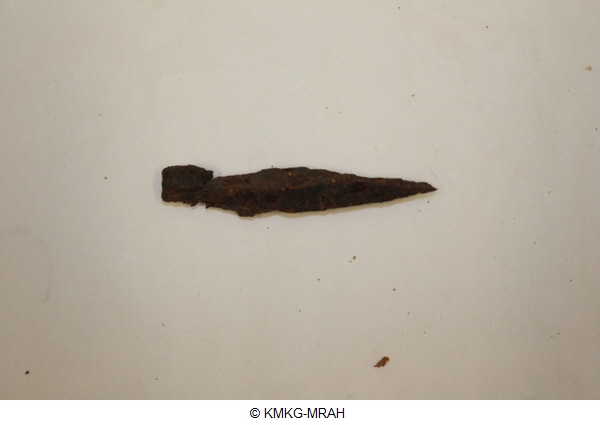
↑ , :
:
collectionName : Middle Ages and Modern TimesinventoryNb : D0095-010
objectName :
objectTitle :
objectCulture :
geography :
dating :
material :
technique :
dimensions :
legalRightOwner : Société Royale d'Archéologie de Bruxelles
objectDescription : The motte-and-bailey castle ‘Senecaberg’ (Grimbergen, Borgt) was first excavated by A. de Loë en A. Rutot (Société Royale d’Archéologie de Bruxelles) in 1890-1891. The first large-scale excavation campaign took place between 1966-1968 and was conducted by René Borremans (assistant of ME. Mariën, curator of the National Archaeology Department from 1957 to 1983). The site was founded in the last quarter of the 11th century by the Lords of Grimbergen and was taken in 1159 by Godfrey III, count of Leuven. In that same year the site was abandoned. In addition to a large amount of artefacts and bone-material, the excavators could document the foundations of different successive wooden structures on top of the mound.

↑ , :
:
collectionName : Middle Ages and Modern TimesinventoryNb : D0095-011
objectName :
objectTitle :
objectCulture :
geography :
dating :
material :
technique :
dimensions : Length: 13,8 cm
legalRightOwner : Société Royale d'Archéologie de Bruxelles
objectDescription : The motte-and-bailey castle ‘Senecaberg’ (Grimbergen, Borgt) was first excavated by A. de Loë en A. Rutot (Société Royale d’Archéologie de Bruxelles) in 1890-1891. The first large-scale excavation campaign took place between 1966-1968 and was conducted by René Borremans (assistant of ME. Mariën, curator of the National Archaeology Department from 1957 to 1983). The site was founded in the last quarter of the 11th century by the Lords of Grimbergen and was taken in 1159 by Godfrey III, count of Leuven. In that same year the site was abandoned. In addition to a large amount of artefacts and bone-material, the excavators could document the foundations of different successive wooden structures on top of the mound.
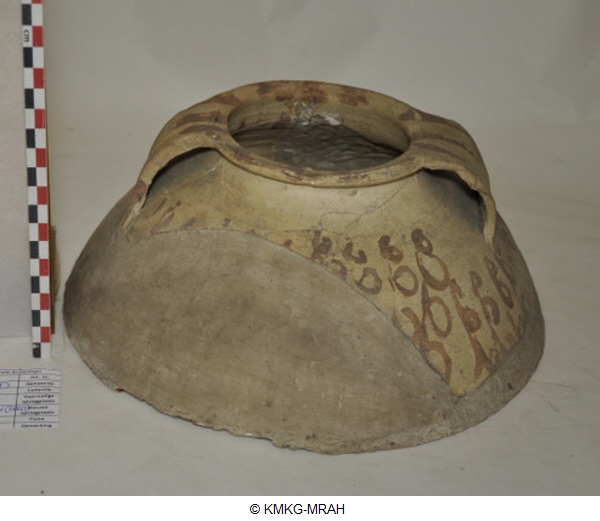
↑ , :
:
collectionName : Middle Ages and Modern TimesinventoryNb : D0095-012
objectName :
objectTitle :
objectCulture :
geography :
dating :
material :
technique :
dimensions :
legalRightOwner : Société Royale d'Archéologie de Bruxelles
objectDescription : The motte-and-bailey castle ‘Senecaberg’ (Grimbergen, Borgt) was first excavated by A. de Loë en A. Rutot (Société Royale d’Archéologie de Bruxelles) in 1890-1891. The first large-scale excavation campaign took place between 1966-1968 and was conducted by René Borremans (assistant of ME. Mariën, curator of the National Archaeology Department from 1957 to 1983). The site was founded in the last quarter of the 11th century by the Lords of Grimbergen and was taken in 1159 by Godfrey III, count of Leuven. In that same year the site was abandoned. In addition to a large amount of artefacts and bone-material, the excavators could document the foundations of different successive wooden structures on top of the mound.

↑ , :
:
collectionName : Middle Ages and Modern TimesinventoryNb : D0095-013
objectName :
objectTitle :
objectCulture :
geography :
dating :
material :
technique :
dimensions :
legalRightOwner : Société Royale d'Archéologie de Bruxelles
objectDescription : The motte-and-bailey castle ‘Senecaberg’ (Grimbergen, Borgt) was first excavated by A. de Loë en A. Rutot (Société Royale d’Archéologie de Bruxelles) in 1890-1891. The first large-scale excavation campaign took place between 1966-1968 and was conducted by René Borremans (assistant of ME. Mariën, curator of the National Archaeology Department from 1957 to 1983). The site was founded in the last quarter of the 11th century by the Lords of Grimbergen and was taken in 1159 by Godfrey III, count of Leuven. In that same year the site was abandoned. In addition to a large amount of artefacts and bone-material, the excavators could document the foundations of different successive wooden structures on top of the mound.

↑ , Scarab with the name of Amon-re (cryptogram):
Scarab with the name of Amon-re (cryptogram) :
collectionName : EgyptinventoryNb : E.04579c
objectName :
objectTitle : Scarab with the name of Amon-re (cryptogram)
objectCulture : Egyptian
geography :
dating : 1550 BC - 1069 BC
material :
technique :
dimensions : Height: 0,8 cm, Width: 0,6 cm, Depth: 0,4 cm
legalRightOwner : Musées royaux d'art et d'histoire/Koninklijke Musea voor Kunst en Geschiedenis
objectDescription : During the New Kingdom scarabs appeared with inscription that could be read, on the basis of the phonetic value of the signs, as cryptograms of the name Amon or Amon Ra. The cobra, for example, has the phonetic value “i”, the duck “mn” and the solar disk “re”. Thus, the signs could form the name “imn ra”.
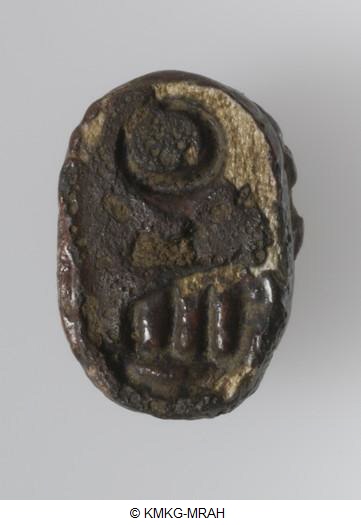
↑ , Scarab:
Scarab :
collectionName : EgyptinventoryNb : E.05354c
objectName :
objectTitle : Scarab
objectCulture : Egyptian
geography :
dating : 747 BC - 525 BC
material :
technique :
dimensions : Height: 1,5 cm, Width: 1 cm, Depth: 1 cm
legalRightOwner : Musées royaux d'art et d'histoire/Koninklijke Musea voor Kunst en Geschiedenis
objectDescription : The base of this scarab with high profile is worn. It shows a few signs, among them the solar disk of Ra and, possibly, the hieroglyph “mn”. The inscription could form the name Amon Ra.

↑ , Scarab:
Scarab :
collectionName : EgyptinventoryNb : E.05379
objectName :
objectTitle : Scarab
objectCulture : Egyptian
geography :
dating : 1295 BC - 1069 BC
material :
technique :
dimensions : Height: 1,3 cm, Width: 0,9 cm, Depth: 0,6 cm
legalRightOwner : Musées royaux d'art et d'histoire/Koninklijke Musea voor Kunst en Geschiedenis
objectDescription : The base of this scarab shows three motifs. From right to left: the obelisk, the seated goddess Maat and the solar disk “ra”. This could be a cryptogram of the name Amon Ra, “imn ra”. The scarab probably dates from the Ramessid Period or somewhat later.
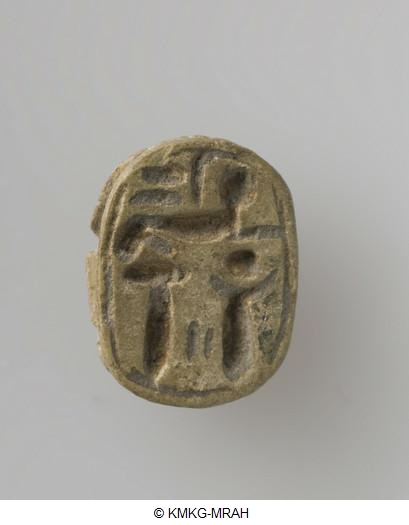
↑ , Scarab:
Scarab :
collectionName : EgyptinventoryNb : E.05601
objectName :
objectTitle : Scarab
objectCulture : Egyptian
geography :
dating : 945 BC - 715 BC
material :
technique :
dimensions : Height: 1 cm, Width: 0,7 cm, Depth: 0,4 cm
legalRightOwner : Musées royaux d'art et d'histoire/Koninklijke Musea voor Kunst en Geschiedenis
objectDescription : The base of this scarab shows a recumbent human-headed sphinx and several hieroglyphs. Above, they form the royal title “nTr [nfr] nb tAwy”, ‘the good god, lord of the Two Lands”. Below, a papyrus plant (“wAdj”) and lotus flower – symbols of Upper and Lower Egypt, placed on either side of two small vertical strokes. Since the sphinx can have the phonetic value “nb”, ‘lord’, the inscription on this scarab could be “lord of Both Lands”. Similar scarabs are ascribed to the 22nd dynasty. The perforated sides point to a date between the 22nd and the 26th dynasty.

↑ , Scarab of Setshasw-Imeniat:
Scarab of Setshasw-Imeniat :
collectionName : EgyptinventoryNb : E.06364
objectName :
objectTitle : Scarab of Setshasw-Imeniat
objectCulture : Egyptian
geography :
dating : 747 BC - 525 BC
material :
technique :
dimensions : Height: 3,5 cm, Width: 1,7 cm, Depth: 2,5 cm
legalRightOwner : Musées royaux d'art et d'histoire/Koninklijke Musea voor Kunst en Geschiedenis
objectDescription : The base of this scarab shows a hieroglyphic inscription in four vertical columns, which mention the title of a governor of Herakleopolis: “rp’t Haty-‘ imy-r (?) mS’ n nn-nswt Haty- ‘wr-ntjr ‘qq chr-Hat pri chr-pHt mdt n.f. nsw m ‘w stja-s(w)-imn-iat”, ‘the hereditary prince, general of Herakleopolis, governor, priest, the one who enters first and exits last, to whom the king speaks when they are alone, Sestsha-Su-Imn-Iat’. According to Luc Limme (personal communication), the circle at the end could be read as “iat”: “Amun-iat”, ‘Amun-of-the-hill’ is a rare form of Amun, typical for the region of Herakleopolis. The Y-shaped line which delineates the pronotum of the scarab, is characteristic for the 25th and 26th dynasties.

↑ , Scarab with ichneumon:
Scarab with ichneumon :
collectionName : EgyptinventoryNb : E.06591e
objectName :
objectTitle : Scarab with ichneumon
objectCulture : Egyptian
geography :
dating : 747 BC - 656 BC
material :
technique :
dimensions : Height: 1,1 cm, Width: 0,8 cm, Depth: 0,5 cm
legalRightOwner : Musées royaux d'art et d'histoire/Koninklijke Musea voor Kunst en Geschiedenis
objectDescription : The base of this scarab bears several hieroglyphs: the ichneumon (Egyptian mongoose), the solar disk “ra” and the ostrich feather “maat”. The inscription could be read as ‘Amun ra’. Similar scarabs date from the 25th dynasty.

↑ , Scarab with ichneumon:
Scarab with ichneumon :
collectionName : EgyptinventoryNb : E.06591f
objectName :
objectTitle : Scarab with ichneumon
objectCulture : Egyptian
geography :
dating : 747 BC - 656 BC
material :
technique :
dimensions : Height: 1 cm, Width: 0,7 cm, Depth: 0,4 cm
legalRightOwner : Musées royaux d'art et d'histoire/Koninklijke Musea voor Kunst en Geschiedenis
objectDescription : The base of this scarab has several hieroglyphs: the ichneumon (Egyptian mongoose), the solar disk “ra” and the ostrich feather “maat”. The inscription could be read as ‘Amun ra’. Similar scarabs date from the 25th dynasty.
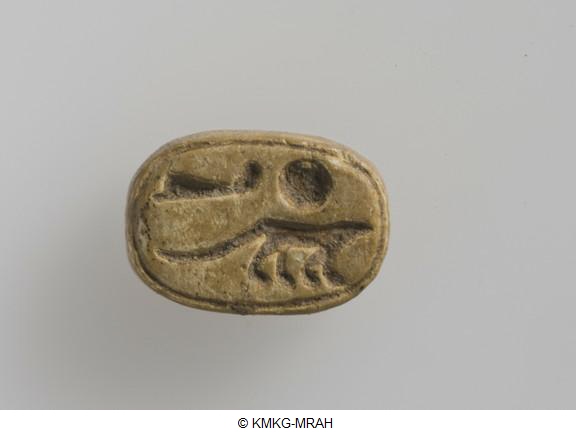
↑ , Scaraboid with ichneumon:
Scaraboid with ichneumon :
collectionName : EgyptinventoryNb : E.06591g
objectName :
objectTitle : Scaraboid with ichneumon
objectCulture : Egyptian
geography :
dating : 747 BC - 656 BC
material :
technique :
dimensions : Height: 0,9 cm, Width: 0,6 cm, Depth: 0,4 cm
legalRightOwner : Musées royaux d'art et d'histoire/Koninklijke Musea voor Kunst en Geschiedenis
objectDescription : The base of this scarab has several hieroglyphs: the ichneumon (Egyptian mongoose), the solar disk “ra” and the ostrich feather “maat”. The inscription could be read as ‘Amun ra’. Similar scarabs date from the 25th dynasty.

↑ , Seal imprint:
Seal imprint :
collectionName : EgyptinventoryNb : E.07789
objectName :
objectTitle : Seal imprint
objectCulture : Egyptian
geography :
dating :
material :
technique :
dimensions : Height: 62 mm, Width: 65 mm, Depth: 37 mm
legalRightOwner : Musées royaux d'art et d'histoire/Koninklijke Musea voor Kunst en Geschiedenis
objectDescription : Door seal (?). Fragment of sealing with seal impression, with clearly defined signs on the obverse and possible traces of organic material. Irregular surface with three imprints. One of these, curved, could be the negative imprint of a small rope or of a curved device. Another is straighter with a smooth part. Dark traces identical to those on the obverse are located on this imprint. The last cannot be identified with any certainty.
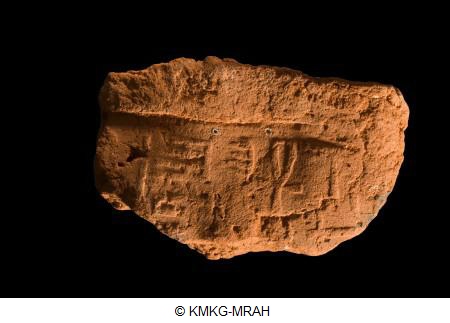
↑ , Seal imprint:
Seal imprint :
collectionName : EgyptinventoryNb : E.07800
objectName :
objectTitle : Seal imprint
objectCulture : Egyptian
geography :
dating :
material :
technique :
dimensions : Height: 43 mm, Width: 63 mm, Depth: 32 mm
legalRightOwner : Musées royaux d'art et d'histoire/Koninklijke Musea voor Kunst en Geschiedenis
objectDescription : Door seal (?). Sealing fragment with seal impression. Obverse: partial seal impression with rather shaded off but well defined signs. There is a characteristic trace of the edge of a cylinder seal. Reverse: three imprints arranged in triangle with numerous dark traces which could be carbonised remains of wood or other organic material.

↑ , Seal imprint:
Seal imprint :
collectionName : EgyptinventoryNb : E.07802
objectName :
objectTitle : Seal imprint
objectCulture : Egyptian
geography :
dating :
material :
technique :
dimensions : Height: 33 mm, Width: 45 mm, Depth: 12 mm
legalRightOwner : Musées royaux d'art et d'histoire/Koninklijke Musea voor Kunst en Geschiedenis
objectDescription : Sealing of a door or box? Fragment of sealing with seal impression. Obverse: partial impression of seal and a characteristic trace of the edge of a cylinder seal. There are dark traces (carbonised remains of wood?). Reverse: two elongated parallel imprints. Inscription and translation (REGULSKI 2009: 39): šn(...); ? ‘nḫ.j (?); personal name Start of two visible signs, on the left-most part of the inscription, which could be the Nḫb (Nekheb / Elkab) group. Legible parts associated with the Elkab /5 sequence (REGULSKI 2009: 39-40, fig.11-12). The sequence corresponds to the Type B of the B. Van de Walle’s classification (VAN DE WALLE 1954: 92). It is also resumed by P. Kaplony (KAPLONY 1963b: 1166; 1963c, fig. 571). Associated fragments: E.7799, E.7800, E.7801, E.7803, E.7804 and E.7805.

↑ , Seal imprint:
Seal imprint :
collectionName : EgyptinventoryNb : E.07806
objectName :
objectTitle : Seal imprint
objectCulture : Egyptian
geography :
dating : unknown
material :
technique :
dimensions : Height: 2,5 cm, Width: 3 cm
legalRightOwner : Musées royaux d'art et d'histoire/Koninklijke Musea voor Kunst en Geschiedenis
objectDescription : Vessel cap. Fragment of sealing with seal impression. The obverse shows a partially shaded off seal impression. There are dark traces which could be carbonised remains of wood or other organic material. The left and thickest side of the fragment is rather regular and rounded off. The reverse has an irregular surface.

↑ , Cylinder seal with figure in front of a tree of life:
Cylinder seal with figure in front of a tree of life :
collectionName : IraninventoryNb : IR.0018
objectName :
objectTitle : Cylinder seal with figure in front of a tree of life
objectCulture : Achaemenid
geography :
dating : 559 BC - 330 BC
material :
technique :
dimensions : Height: 2,7 cm
legalRightOwner : Musées royaux d'art et d'histoire/Koninklijke Musea voor Kunst en Geschiedenis
objectDescription : This seal has been quite famous ever since the identification of its inscription as an Old Persian name by the assyriologists J. Ménant and J. Oppert. Given in 1861 by the art collector Gustave Hagemans to the then Musée des Armures in the Porte de Hal, Brussels (now preserved in the Musées royaux d’Art et d’Histoire), the cylinder seal was first published, with a picture and a transliteration, in Ménant 1877. At that time Old Persian inscriptions were scarce, hence its success. The seal shows a male figure, a wreath (?) in his hand, standing near a tree. The stylized tree is reminiscent of Neo-Assyrian iconography, and the offering of a crown is uncommon and attested rather from the Parthian period in the 3rd century BC. No parallel found. The framed inscription is composed of three lines, vertically written, from bottom to top, and to be read on the seal, which is unusual for the Achaemenid period. The bizarre spelling of Xerxes was first read as “Kharsā…siyā” (Kharsā son of Siyā or Kharsāisiyā; Ménant 1878a), “Khsarasasya” or alternatively “the woman Khsarsya” (Ménant 1886, 172), then as “Kharšadašia” (Speleers 1923, 217). The particle ma- was interpreted as a logogram for “seal” by Ménant, some sort of abbreviation of the Old Persian māraka (cf. also Oppert 1884; Kent 1953, 201) and by a 1st person pronoun by Speleers (“Je (suis) Kharšadašia”). Yet, the 1st person should be adam, as in other seals, and this ma- is considered as dubious (Kent 1953, 201). In the da-sign, the top horizontal wedge is missing. The stroke after the first sign (ma) is a divider, transliterated here as “:”. The form X-r-š-a-d?-š-y-a should probably be read X-š-y-a-r-š-a, after inverting line 2 and line 3 (Mayrhofer 1979) to have a nominative sing. ending in –ša. ma:x- r-š-a- da!-š-y-a “Seal of (?) Xerxes” This inscription is either a late (but genuine) imitation, or a modern forgery. The unusual lay-out of the inscription, the misshaped design and the bizarre spelling for the name of Xerxes, not to mention the iconography, could point to a forgery. However, in 1888 only three additional cylinder seals with Old Persian cuneiform signs were known to scholars (Ménant 1888, 12), all preserved in the collections of the British Museum, but we know that copies were produced in Iran at that time.
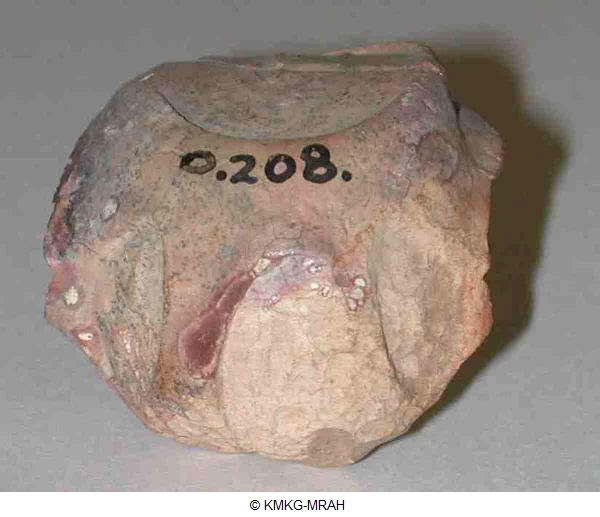
↑ , Bull with ten seal imprints:
Bull with ten seal imprints :
collectionName : Near EastinventoryNb : O.00208
objectName :
objectTitle : Bull with ten seal imprints
objectCulture : Seleucid
geography :
dating : 175 BC - 164 BC
material :
technique :
dimensions : Height: 4 cm, Width: 4 cm
legalRightOwner : Musées royaux d'art et d'histoire/Koninklijke Musea voor Kunst en Geschiedenis
objectDescription : The bulla has an elliptical shape with a similarly-shaped hole through the middle. Ten imprints can be observed; Speleers mentioned “multiple imprints” and published seven of them. The largest is a well-known Amtssiegel depicting a standing Nike and its use can be dated to the reign of Antiochus III (223-187 BC). As is the case for some of the other bullae (see remarks under O.206 and § 4. Images), a number of stamp imprints have been partly or even completely destroyed since their discovery and therefore, if available, additional images of the imprints are provided below. In case the new scans of the imprints on the bulla could not be associated with the pictures published by Speleers, they are discussed at the end of the general descriptions. 208 A: standing Nike, holding object; inscription 208 B: unidentifiable (worn) imprint 208 C: kneeling Eros 208 D: winged human-headed scorpion monster; facing seated dog 208 E: uncertain (standing/walking bull) 208 F: unidentifiable (worn) imprint 208 G: unidentifiable (worn) imprint 208 H: unidentifiable (worn) imprint 208 I: standing quadruped (standing/walking bull?) 208 J: unidentifiable (worn) imprint
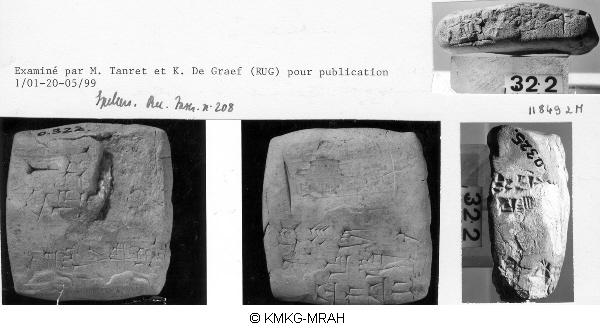
↑ , Cuneiform tablet with cylinder seal impression:
Cuneiform tablet with cylinder seal impression :
collectionName : Near EastinventoryNb : O.00322
objectName :
objectTitle : Cuneiform tablet with cylinder seal impression
objectCulture : Mesopotamia
geography :
dating : 2037 BC - 2029 BC
material :
technique :
dimensions : Height: 4,2 cm, Width: 4 cm, Depth: 1,5 cm
legalRightOwner : Musées royaux d'art et d'histoire/Koninklijke Musea voor Kunst en Geschiedenis
objectDescription : The second year of the rule of Shu-Suen. Year in which the schip “ibex of Abzu” was build (mu ma2 dara abzu ba-du8). Line 2, the trace of the last sign is an horizontal stroke; it could be a LUGAL-sign as well. An individual with the same name and patronym is attested in Girsu on a tablet dating from Amar-Sîn 2, 10 years earlier than this receipt (ITT 2, 741, rev. col.v,3’; cf. http://cdli.ucla.edu/P110610). ˹lugal-ú˺-˹šim˺ dub.sar ˹maḫ?˺ DUMU ur-sa6-ga “Lugal-ušim, chief (?) scribe, son of Ur-saga”.

↑ , :
:
collectionName : Near EastinventoryNb : O.04487
objectName :
objectTitle :
objectCulture : Southern Levant
geography :
dating : ca. 3200 BC
material :
technique :
dimensions : Height: 15,2 cm
legalRightOwner : Musées royaux d'art et d'histoire/Koninklijke Musea voor Kunst en Geschiedenis
objectDescription : Ban edh-Dhra’ is situated on the Jordan side of the Dead Sea, east of the Ghor el Mazra’a and the Lisan peninsula, at an altitude of 240m above sea level. The site contains, among others, a fortified city on the southern bank of the Wadi Kerak and a vast necropolis south-west of the urban settlement, both dated to the Early Bronze Age. Tomb A79 consists of four cylindrical chambers and contains the remains of human skeletons as well as numerous grave goods primarily consisting of pottery. The pottery of this period was always sculpted by hand, sometimes finished with a thin , possibly polished, layer of red slip, and is characterized by its diverse functional shapes. These could be middling size bowl to big deep bowls, Jugs with or without vertical handles, storing jars with overhanging handles, miniature jars or bottles and small shallow bowls. Bowls were often supplied with horizontal handles or clay knobs set onto the edge of the bowl at regular intervals. The pots could be decorated with one or two bands of stamped dots, presumably pressed into the still wet clay by the potter with a rood. This kind of ornamentation could also be found on jars and was considered characteristic to the Bab edh-Dhra’ pottery. Sometimes bowls would have a rounded bottom – as opposed to jugs, which often contained fluids and thus needed a flattened bottom to stabilize the vessel. In order to better handle the jars and to easily pour or draw water and other fluids, the jugs were supplied with vertical handle. Sometimes horizontal overhanging handles were also found, always placed on the belly of the vessel. To improve the quality of the clay the pots were produced with, the potters had to add supplementary material such as wadi sand, quartz, limestone grit and pebblestones to the clay mixture. I.M.S.

